|
|
BOLIVIA: 07.09. - 12.11.2007
|
Route: San Juan, Concha K, Salar Uyuni, Tambo Tambillo,
Quillacas, Challapata, Oruro, El Alto, La Paz, Caranavi, Rurrenabaque,
La Paz, Copacabana, Isla de Sol, Sorata, La Paz, Copacabana
Distance Bike: 1135 km Ascent: 6000 m
Distance boat: about 300 Km
|
| |
|
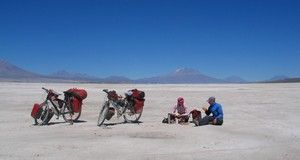 Preface: In the introduction
to Bolivia says our guide, that in Bolivia expect the unexpected,
and thus meets the nail on the head. We will Bolivianern mainly
by the very warm welcome, particularly in LA Paz Hardly a day on
which it is not either a festival, a parade or at least a small
demonstration (some demonstrations have also almost Umzugscarakter).
Bolivia landscape is incredibly diverse and snow and barren peaks
of Hochgebirgswüsten Amazon Jungle to meet here on almost every
conceivable climate zones. Especially in tents Altiplano is relatively
easy. Preface: In the introduction
to Bolivia says our guide, that in Bolivia expect the unexpected,
and thus meets the nail on the head. We will Bolivianern mainly
by the very warm welcome, particularly in LA Paz Hardly a day on
which it is not either a festival, a parade or at least a small
demonstration (some demonstrations have also almost Umzugscarakter).
Bolivia landscape is incredibly diverse and snow and barren peaks
of Hochgebirgswüsten Amazon Jungle to meet here on almost every
conceivable climate zones. Especially in tents Altiplano is relatively
easy.
|
| |
|
224. Weekly report 07.09. - 16.09.2007
Route: San Juan, Concha K, Salar Uyuni, Tambo Tambillo, Quillacas,
Challapata, Oruro
|
| |
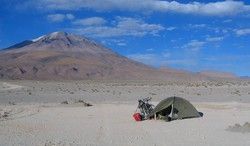 Welcome to Bolivia: Nevertheless, immediately
with the entry formalities the first disillusionment, the border official
requires all at once 15 Bolivianos (about 1.50 €) from us for the
entry stamp. Ordinarily one must pay the money, nevertheless, only
with the crossing the border, however, with foreign tourists one can
make quietly sometimes an exception. Because we had not succeeded
in Chile, nevertheless Bolivianos (BS) in acquiring to a more or less
satisfactory course (the Chileans have offered the exchange to 30%
under course value to us!!!) we have of course no 15 BS per nose.
Then, nevertheless, alternatively the border official accepts also
"generous-wise" US $, however, now we must pay per nose 3 US $ (instead
of ordinarily 2 US $). Long live the corruption!!!! Welcome to Bolivia: Nevertheless, immediately
with the entry formalities the first disillusionment, the border official
requires all at once 15 Bolivianos (about 1.50 €) from us for the
entry stamp. Ordinarily one must pay the money, nevertheless, only
with the crossing the border, however, with foreign tourists one can
make quietly sometimes an exception. Because we had not succeeded
in Chile, nevertheless Bolivianos (BS) in acquiring to a more or less
satisfactory course (the Chileans have offered the exchange to 30%
under course value to us!!!) we have of course no 15 BS per nose.
Then, nevertheless, alternatively the border official accepts also
"generous-wise" US $, however, now we must pay per nose 3 US $ (instead
of ordinarily 2 US $). Long live the corruption!!!! |
| |
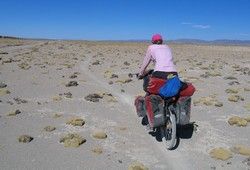 Where to go? According to tourist guides
will be in Bolivia ungemachte a road to the Salar de Uyuni, but the
streets here to make us an excellent impression. Other roads, there
are loud card. Slightly irritated, however, we are, as the road map
is not how loud the railway line item, but something more towards
the south. Sicherheitshalber again we ask the Customs, if the right
road. Yeah, it says, the road goes to Uyuni. We follow the really
good gravel runway, but instead of the expected change of direction
to the east is continually to the southwest. After about 15 Km we
keep oncoming pickup in order again after the road to ask. The two
very nice Bolivians tell us now that this was a new road in the town
of Uyuni also would lead, but a small sheet and would not Salar de
Uyuni direction would lead. If we wanted to Salar then we would have
something and then cycle back on a small road north to eventually
cycle back to the old way, the railway follows, to take. The small
road is extremely sandy, and so we push cycle and a 5 km before we
have our tent in the dark detail. On the only sign that we see is
the label already up beyond abgeblättert and thus no real help. The
next morning we cycle down to the level, but now the road forks. Right,
east and actually our direction, the path but after one kilometer
into an old mine, so we left the path (west) to choose, but back to
the border seems to lead. Would prefer us a way north towards the
railway line, but the there are not. We follow the road west for a
while and just as we in a small crisis meeting to decide on is whether
we have the way through the mine should take or directly on the Salar
should ride to the north, we see on the northern horizon (where we
hinwollen ), The dust cloud of a jeep. Gespannt we follow the jeep
always behind the hills disappear, with our eyes and after about 15
minutes he is not far from us over and disappears to the south. Ok.
because the road is so long. We follow the deadlocked lane, still
face a number of other tourist jeeps, and after a few kilometres we
finally reach the railway line. How are back on the right track! But
it that the lane (path or road would be an exaggeration) in parallel
to the railway runs can not talk. Once we see the railway tracks are
still on the horizon just briefly again next to her. At a military
camp, the lanes at once on the Salar de Chuguana north instead, according
to the map to the East, but we follow safety times the lanes, because
we then some tourists have come jeeps. Confusion comes up again, we
San Juan, the next city control, according to the card directly into
the railway line, but the only houses we see are about 10 Km from
being in the mountains. We trust in the lanes and to our astonishment,
the place really in the hills of San Juan. The last kilometer however,
we need to push through deep sand. From here it continues to Concha
K, a slightly larger city, according to the itinerary of a Swiss Radlers
scarce, 18 kilometres away would have. We follow an evil places corrugated
iron and sand runway and after 12 kilometers, at once a sign "Concha
K to the left". Unfortunately, however, are three ways to the left,
and it is good advice once again expensive. We have good luck and
again after a few minutes a tourist jeep us on the right of three
ways. The lanes lead again through open countryside with some branches
but in the end we reach sound after 30 Km Concha K. Apparently, the
Swiss cyclist whose information otherwise excellent, there is some
abbreviation. Where to go? According to tourist guides
will be in Bolivia ungemachte a road to the Salar de Uyuni, but the
streets here to make us an excellent impression. Other roads, there
are loud card. Slightly irritated, however, we are, as the road map
is not how loud the railway line item, but something more towards
the south. Sicherheitshalber again we ask the Customs, if the right
road. Yeah, it says, the road goes to Uyuni. We follow the really
good gravel runway, but instead of the expected change of direction
to the east is continually to the southwest. After about 15 Km we
keep oncoming pickup in order again after the road to ask. The two
very nice Bolivians tell us now that this was a new road in the town
of Uyuni also would lead, but a small sheet and would not Salar de
Uyuni direction would lead. If we wanted to Salar then we would have
something and then cycle back on a small road north to eventually
cycle back to the old way, the railway follows, to take. The small
road is extremely sandy, and so we push cycle and a 5 km before we
have our tent in the dark detail. On the only sign that we see is
the label already up beyond abgeblättert and thus no real help. The
next morning we cycle down to the level, but now the road forks. Right,
east and actually our direction, the path but after one kilometer
into an old mine, so we left the path (west) to choose, but back to
the border seems to lead. Would prefer us a way north towards the
railway line, but the there are not. We follow the road west for a
while and just as we in a small crisis meeting to decide on is whether
we have the way through the mine should take or directly on the Salar
should ride to the north, we see on the northern horizon (where we
hinwollen ), The dust cloud of a jeep. Gespannt we follow the jeep
always behind the hills disappear, with our eyes and after about 15
minutes he is not far from us over and disappears to the south. Ok.
because the road is so long. We follow the deadlocked lane, still
face a number of other tourist jeeps, and after a few kilometres we
finally reach the railway line. How are back on the right track! But
it that the lane (path or road would be an exaggeration) in parallel
to the railway runs can not talk. Once we see the railway tracks are
still on the horizon just briefly again next to her. At a military
camp, the lanes at once on the Salar de Chuguana north instead, according
to the map to the East, but we follow safety times the lanes, because
we then some tourists have come jeeps. Confusion comes up again, we
San Juan, the next city control, according to the card directly into
the railway line, but the only houses we see are about 10 Km from
being in the mountains. We trust in the lanes and to our astonishment,
the place really in the hills of San Juan. The last kilometer however,
we need to push through deep sand. From here it continues to Concha
K, a slightly larger city, according to the itinerary of a Swiss Radlers
scarce, 18 kilometres away would have. We follow an evil places corrugated
iron and sand runway and after 12 kilometers, at once a sign "Concha
K to the left". Unfortunately, however, are three ways to the left,
and it is good advice once again expensive. We have good luck and
again after a few minutes a tourist jeep us on the right of three
ways. The lanes lead again through open countryside with some branches
but in the end we reach sound after 30 Km Concha K. Apparently, the
Swiss cyclist whose information otherwise excellent, there is some
abbreviation. |
| |
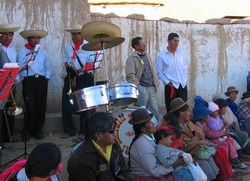 Festival in Concha K: Although is marked
in our map as a provincial centre Concha K a small place in which
there are, nevertheless, some stores which use to us in the absence
of Bolivianos, nevertheless, anyhow nothing. Nevertheless, in the
village just a religious festival town finds and thus are all inhabitants
on the legs. Something behind the marketplace is the real fairground
on itself everything has gathered around to the music of a brass band
to dance. The party already seems to be some hours going, because
nearly all adult, men like women, are completely got drunk. Many are
so got drunk even that it is a miracle that they can keep generally
still on the legs, or can still dance. We do not want to disturb the
playful mood of the party further (anyhow we feel to us is absent
on the place) and there it already shortly before sundown is we still
fill in fast our water bottles and cycle a few more kilometres farther. Festival in Concha K: Although is marked
in our map as a provincial centre Concha K a small place in which
there are, nevertheless, some stores which use to us in the absence
of Bolivianos, nevertheless, anyhow nothing. Nevertheless, in the
village just a religious festival town finds and thus are all inhabitants
on the legs. Something behind the marketplace is the real fairground
on itself everything has gathered around to the music of a brass band
to dance. The party already seems to be some hours going, because
nearly all adult, men like women, are completely got drunk. Many are
so got drunk even that it is a miracle that they can keep generally
still on the legs, or can still dance. We do not want to disturb the
playful mood of the party further (anyhow we feel to us is absent
on the place) and there it already shortly before sundown is we still
fill in fast our water bottles and cycle a few more kilometres farther. |
| |
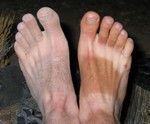 Shows here your feet: Up here the dusty
washing board runways are a really very first cream and as thankfully
as we are to the tourist jeeps for her guidance, thus we are also
irritated by the gigantic clouds of dust them whirl up if them to
us vorbeibrettern. In spite of scanty stores of water we wash every
evening around the thick dust layers we abzuschrubben. Shows here your feet: Up here the dusty
washing board runways are a really very first cream and as thankfully
as we are to the tourist jeeps for her guidance, thus we are also
irritated by the gigantic clouds of dust them whirl up if them to
us vorbeibrettern. In spite of scanty stores of water we wash every
evening around the thick dust layers we abzuschrubben. |
| |
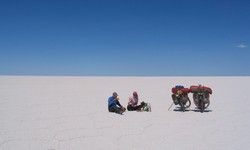 Salar Uyuni: The next day, finally, then it goes on
the Salar de Uyuni, the biggest and highest salt lake of the earth
on 3653 m. After many washing board runways and sandy runways of the
last days cycling on the smooth and firm salt crust is a true relief.
We were real a little bit anxiously because of the orientation on
the Salar, however, thanks to the road description of the Swiss and
the black lanes not to be overlooked (thanks to tyre wear) of the
tourist jeeps the orientation is absolutely trouble-free. About 40
km we go dead-straight northwards up to Isla Inkawasi who lies here
in the middle of the Salar. One can see the island, by the way, already
from 30 km of distance. Salar Uyuni: The next day, finally, then it goes on
the Salar de Uyuni, the biggest and highest salt lake of the earth
on 3653 m. After many washing board runways and sandy runways of the
last days cycling on the smooth and firm salt crust is a true relief.
We were real a little bit anxiously because of the orientation on
the Salar, however, thanks to the road description of the Swiss and
the black lanes not to be overlooked (thanks to tyre wear) of the
tourist jeeps the orientation is absolutely trouble-free. About 40
km we go dead-straight northwards up to Isla Inkawasi who lies here
in the middle of the Salar. One can see the island, by the way, already
from 30 km of distance.
|
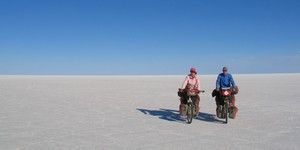 A dream in white: A dream in white: |
| |
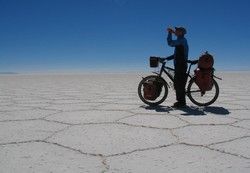 Hexagon-shaped salt edges: To
destroy the nice hexagonal salt edges not needlessly we also keep
quite well to the lanes (except around briefly a few photos to make). Hexagon-shaped salt edges: To
destroy the nice hexagonal salt edges not needlessly we also keep
quite well to the lanes (except around briefly a few photos to make).
|
| |
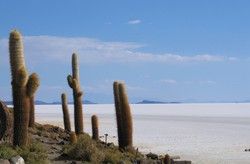 Isla Inkawasi: Though Isla Inkawasi is
not the only island on the Salar, however she lies where to herself
the main routes on the Salar cruise and, besides, still about a restaurant
disposes, it is the approach point for all tourist jeeps. The island
itself is covered with many old cacti (should be 1200 years old to).
Because the whole scenery lay here once under the sea covertly, there
are on the island still many corals what looks a little bit droll
up here on the Altiplano of course. We fill in our stores of water
with the restaurant again and then disappear on the quieter south
side of the islands around a few photo admissions to make. Here, actually,
we also want to whip our tent, because we can enjoy thus sundown as
well as from sunrise, however, suddenly a storm-like west wind starts,
so that we must proceed in the windbreak of the island and can make
to no nice sundown photos. Isla Inkawasi: Though Isla Inkawasi is
not the only island on the Salar, however she lies where to herself
the main routes on the Salar cruise and, besides, still about a restaurant
disposes, it is the approach point for all tourist jeeps. The island
itself is covered with many old cacti (should be 1200 years old to).
Because the whole scenery lay here once under the sea covertly, there
are on the island still many corals what looks a little bit droll
up here on the Altiplano of course. We fill in our stores of water
with the restaurant again and then disappear on the quieter south
side of the islands around a few photo admissions to make. Here, actually,
we also want to whip our tent, because we can enjoy thus sundown as
well as from sunrise, however, suddenly a storm-like west wind starts,
so that we must proceed in the windbreak of the island and can make
to no nice sundown photos. |
| |
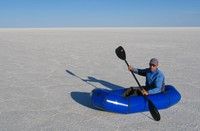 Paddking: Once in the life on a salt lake paddle I
imagined and make our Packrafts ready to be launched. Nevertheless,
unfortunately, I do not come anyhow so properly from the spot. This
is a nice lake if one can not even paddle on him.:-))) Paddking: Once in the life on a salt lake paddle I
imagined and make our Packrafts ready to be launched. Nevertheless,
unfortunately, I do not come anyhow so properly from the spot. This
is a nice lake if one can not even paddle on him.:-))) |
| |
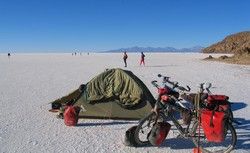 Marathon group: After we spend in the lee
of the island and when we the next morning with sunrise from the tent
have an eye we do not look badly when all at once a whole group of
joggers goes past!!! The group exists of 21 predominantly American
marathon runners who take a "run vacation" here in South America.
At the latest every 2nd day is run, and is denied every now and then
also a marathon (one is in a few days in the brine Titicaca).Für today
are attached on the Salar 21 km, before it further goes to Potosi.
Most runners are not acclimatised yet completely so optimally, finally,
we are on 3650 m, and thus they allow to concern it relatively quietly.
In the group is also a German marathon runner who has denied a marathon
on the North Pole in spite of his old age (nearly 70) only few weeks
ago. Marathon group: After we spend in the lee
of the island and when we the next morning with sunrise from the tent
have an eye we do not look badly when all at once a whole group of
joggers goes past!!! The group exists of 21 predominantly American
marathon runners who take a "run vacation" here in South America.
At the latest every 2nd day is run, and is denied every now and then
also a marathon (one is in a few days in the brine Titicaca).Für today
are attached on the Salar 21 km, before it further goes to Potosi.
Most runners are not acclimatised yet completely so optimally, finally,
we are on 3650 m, and thus they allow to concern it relatively quietly.
In the group is also a German marathon runner who has denied a marathon
on the North Pole in spite of his old age (nearly 70) only few weeks
ago. |
| |
|
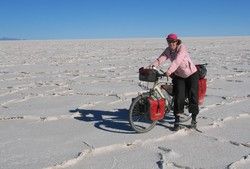 Salar Uyuni to push: According to our map
it looks thus as if it was to be driven substantially shorter by
Isla Inkawasi to north-east directly to Tacarani than about the
Salinas Garcia in the north. Without further ado we resolve to try
our luck. First everything still runs rather well and thus we come
to the east of the volcano Tunapa to a nice small place before a
gigantic herd Llamas puts out to pasture and with on a small
lagoon bulky flamingos are to be admired. I ask a Llamahirtin
which direction we should smash best of all around about the Salar
to Tacarani to come, however, unfortunately, woman has no notion
whether and what for places are on the other side of the Salar.
Thus we drive off roughly after feeling, because our compass has
a gigantic air bubble and is also not particularly helpful. Because
none of the lanes in the direction aimed by us leads we simply cycle
"quersalzein". The salt is nicely firm and crunches as really coldly
frozen snow. Nevertheless, after a while the salt becomes more humid,
we sink even something, and everywhere from the tyres it splashes
there. We change our direction a little bit southwards and come
so luckily again to more firm regions. Nevertheless, after some
kilometres the surface of the Salar changes once more and instead
of the nice smooth roadway with the hexagonal fields now it is very
rough and hubbelig. Our speed decreases from comfortable 18 km/h
on strenuous 10 km/h. After a while the salt becomes more humid
and softer again, and we become even slower. At last it goes off
in such a way that we must descend and push. Suddenly the salt changes
suddenly and we deal it with soft quite fine loose mud. Our heavy
bicycles deeply sink and thus we struggle laboriously pushing forward.
All together we push our wheels 7 km, before we reach firm reason
shortly before sundown again. To our joy we can see a few kilometres
farther a small village. Tacarani, as we hope. We cycle and push
on sandy runways in de small place where we shortly after sundown
come. As we are found out now we though not in Tacarani landed,
but in a little village with 3 families about 10 km farther to the
north, however because we anyhow want further to the north only
suits us. Nevertheless, at last from 50 km easy according to map
of stage (abbreviation) quite strenuous 80 km of day has become. Salar Uyuni to push: According to our map
it looks thus as if it was to be driven substantially shorter by
Isla Inkawasi to north-east directly to Tacarani than about the
Salinas Garcia in the north. Without further ado we resolve to try
our luck. First everything still runs rather well and thus we come
to the east of the volcano Tunapa to a nice small place before a
gigantic herd Llamas puts out to pasture and with on a small
lagoon bulky flamingos are to be admired. I ask a Llamahirtin
which direction we should smash best of all around about the Salar
to Tacarani to come, however, unfortunately, woman has no notion
whether and what for places are on the other side of the Salar.
Thus we drive off roughly after feeling, because our compass has
a gigantic air bubble and is also not particularly helpful. Because
none of the lanes in the direction aimed by us leads we simply cycle
"quersalzein". The salt is nicely firm and crunches as really coldly
frozen snow. Nevertheless, after a while the salt becomes more humid,
we sink even something, and everywhere from the tyres it splashes
there. We change our direction a little bit southwards and come
so luckily again to more firm regions. Nevertheless, after some
kilometres the surface of the Salar changes once more and instead
of the nice smooth roadway with the hexagonal fields now it is very
rough and hubbelig. Our speed decreases from comfortable 18 km/h
on strenuous 10 km/h. After a while the salt becomes more humid
and softer again, and we become even slower. At last it goes off
in such a way that we must descend and push. Suddenly the salt changes
suddenly and we deal it with soft quite fine loose mud. Our heavy
bicycles deeply sink and thus we struggle laboriously pushing forward.
All together we push our wheels 7 km, before we reach firm reason
shortly before sundown again. To our joy we can see a few kilometres
farther a small village. Tacarani, as we hope. We cycle and push
on sandy runways in de small place where we shortly after sundown
come. As we are found out now we though not in Tacarani landed,
but in a little village with 3 families about 10 km farther to the
north, however because we anyhow want further to the north only
suits us. Nevertheless, at last from 50 km easy according to map
of stage (abbreviation) quite strenuous 80 km of day has become.
|
| |
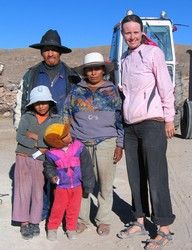 Sonja and Ludgardo part 1: I believe we
look tired after many pushing a little bit and exhausted, because
when we will want to fill in, actually, only water we from Sonja and
her neighbour, an older South American Indian's woman in the traditional
Petticoat and Bowlerhut (melon), directly on a cup of tea invited.
The kitchen of the neighbour is pitch-dark, no window has and thus
some light comes in merely by the Türe. We are allowed to do ourselves
on the bed placed, while the neighbour puts a kettle to water on the
gas range standing on the ground and lights afterwards a small oil
lamp. The oil lamp exists merely of a wick in a tin full with oil.
Presumably we also look half starved, because to the cup of tea we
still get a piece of fried white bread. After we are supplied with
the most necessary one soy and her neighbour withdraw and we sit alone
in the twilight and strengthen ourselves in the easy however comfortable
kitchen. Actually, we want again from the place rausradeln around
our tent to be based, however, Sonja and Ludgardo (her husband) persuade
us that it is not clever in get dark on the sandy runway rumzueiern
and offer us that we can whip with pleasure our tent here beside the
chapel. I help Sonja on plastic foils to the drily laid out grain
punch (Chinua, any millet-like grain) zusammenzuräumen, so
that we have a level place for our tent. We have put away just the
tent, as Sonja to us one more room offers in we could sleep, however,
to move over again, nevertheless, we are too exhausted and thus we
decline with thanks. Nevertheless, at least an invitation for the
dinner for later insists they. Sonja disappears in any of the houses
to the cooking and we furnish our tent further. Although it is already
dark and is cold a little bit, nevertheless, we leave open the Zelttüre
to be accessible furthermore. After 1.5 hours, we freeze substantially
and can keep open the eyes hardly more, a possibly ten-year-old girl
stands all at once in get dark before our tent and looks to us in
without what to say. We say "hello", however, the little one is still
taciturn. Finally, I ask the girl whether she speaks in Spanish (in
rural Gegeden the language of the Incas and Aymara is spoken in Bolivia
because still often Quechua) what she answers with a short scanty
"Si", before she goes to ruin again in the silence. Finally, after
some minutes she says something like"mummy" and "Sopa" and has faster
disappeared than the flash. OK. now true probably the info that the
dinner is ready, however, in which of the houses we should come then.
Uncertainly we wander around the houses and after half an eternity
a Türe goes all at once Sonja rises from to us joyfully entgegenwinkt.
The culinary small house resembles rather a storeroom for grain and
unused utensils and the only one what reveals that the space is also
used as a kitchen is a gas range which stands in a corner. Sonja sits
in the candle-light between some bowls and a big soup pot on the ground.
Immediately we get two small stools offered. Nevertheless, I offer
my small stool of the neighbour, because I do not want that them on
the ground must sit, however, from from somewhere she conjures all
at once still a small seat opportunity. A few minutes later there
comes Ludgardo, whereupon itself the neighbour discreetly moves back.
Now everybody gets a full bowl with the fervently steaming tasty soup.
Jaqueline, Sojas and Ludgardos daughter to us to food has called,
sits down on a few grain bags, while her smaller three-year-old brother
means he has no hunger and now would go to bed. The soup is marvellous
and warms up us again so really nicely from the inside. It is eaten
in silence. Not which we would have to tell ourselves nothing mutually,
however, in particular Ludgardo is exhausted very much by the work
and drops off even every now and then something. After food we tell
something else about our trip and our everyday life as a bicycle traveller
and we report merely about our trip here in South America before we
dead tired in the bed fall. Sonja and Ludgardo part 1: I believe we
look tired after many pushing a little bit and exhausted, because
when we will want to fill in, actually, only water we from Sonja and
her neighbour, an older South American Indian's woman in the traditional
Petticoat and Bowlerhut (melon), directly on a cup of tea invited.
The kitchen of the neighbour is pitch-dark, no window has and thus
some light comes in merely by the Türe. We are allowed to do ourselves
on the bed placed, while the neighbour puts a kettle to water on the
gas range standing on the ground and lights afterwards a small oil
lamp. The oil lamp exists merely of a wick in a tin full with oil.
Presumably we also look half starved, because to the cup of tea we
still get a piece of fried white bread. After we are supplied with
the most necessary one soy and her neighbour withdraw and we sit alone
in the twilight and strengthen ourselves in the easy however comfortable
kitchen. Actually, we want again from the place rausradeln around
our tent to be based, however, Sonja and Ludgardo (her husband) persuade
us that it is not clever in get dark on the sandy runway rumzueiern
and offer us that we can whip with pleasure our tent here beside the
chapel. I help Sonja on plastic foils to the drily laid out grain
punch (Chinua, any millet-like grain) zusammenzuräumen, so
that we have a level place for our tent. We have put away just the
tent, as Sonja to us one more room offers in we could sleep, however,
to move over again, nevertheless, we are too exhausted and thus we
decline with thanks. Nevertheless, at least an invitation for the
dinner for later insists they. Sonja disappears in any of the houses
to the cooking and we furnish our tent further. Although it is already
dark and is cold a little bit, nevertheless, we leave open the Zelttüre
to be accessible furthermore. After 1.5 hours, we freeze substantially
and can keep open the eyes hardly more, a possibly ten-year-old girl
stands all at once in get dark before our tent and looks to us in
without what to say. We say "hello", however, the little one is still
taciturn. Finally, I ask the girl whether she speaks in Spanish (in
rural Gegeden the language of the Incas and Aymara is spoken in Bolivia
because still often Quechua) what she answers with a short scanty
"Si", before she goes to ruin again in the silence. Finally, after
some minutes she says something like"mummy" and "Sopa" and has faster
disappeared than the flash. OK. now true probably the info that the
dinner is ready, however, in which of the houses we should come then.
Uncertainly we wander around the houses and after half an eternity
a Türe goes all at once Sonja rises from to us joyfully entgegenwinkt.
The culinary small house resembles rather a storeroom for grain and
unused utensils and the only one what reveals that the space is also
used as a kitchen is a gas range which stands in a corner. Sonja sits
in the candle-light between some bowls and a big soup pot on the ground.
Immediately we get two small stools offered. Nevertheless, I offer
my small stool of the neighbour, because I do not want that them on
the ground must sit, however, from from somewhere she conjures all
at once still a small seat opportunity. A few minutes later there
comes Ludgardo, whereupon itself the neighbour discreetly moves back.
Now everybody gets a full bowl with the fervently steaming tasty soup.
Jaqueline, Sojas and Ludgardos daughter to us to food has called,
sits down on a few grain bags, while her smaller three-year-old brother
means he has no hunger and now would go to bed. The soup is marvellous
and warms up us again so really nicely from the inside. It is eaten
in silence. Not which we would have to tell ourselves nothing mutually,
however, in particular Ludgardo is exhausted very much by the work
and drops off even every now and then something. After food we tell
something else about our trip and our everyday life as a bicycle traveller
and we report merely about our trip here in South America before we
dead tired in the bed fall. |
| |
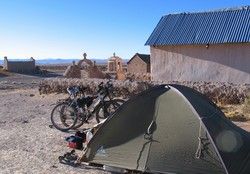 Sonja and Ludgardo part 2: The next morning
brings and Sonja a freshly fried bread for the breakfast to the tent
and mean, nevertheless, we should stay here one more day and rest
a little. Now we are in the catch-22 situation. Loving with pleasure
we would spend one more day with Sonja and her family, however, by
no means we want to lie to them on the pocket and allow to feed us
again from them. Now ordinarily we would offer that we would cook
today for everybody, however, our stocks of food are limited just
more than only. We could still exchange no money and have no Boliviano
in the pocket, and up to the next place where we hopefully on a bank
hit these are still more than 150 km on grit runways. We have to eat
just enough that we if everything well runs these can reach. Should
we need, nevertheless, longer than two days would be fast announced.
Long we turn over in the mind and, nevertheless, finally, we decide
in addition to go on. The resignation hurts, in particular, because
Sonja tells us that we were the first guests in her life. Sonja and Ludgardo part 2: The next morning
brings and Sonja a freshly fried bread for the breakfast to the tent
and mean, nevertheless, we should stay here one more day and rest
a little. Now we are in the catch-22 situation. Loving with pleasure
we would spend one more day with Sonja and her family, however, by
no means we want to lie to them on the pocket and allow to feed us
again from them. Now ordinarily we would offer that we would cook
today for everybody, however, our stocks of food are limited just
more than only. We could still exchange no money and have no Boliviano
in the pocket, and up to the next place where we hopefully on a bank
hit these are still more than 150 km on grit runways. We have to eat
just enough that we if everything well runs these can reach. Should
we need, nevertheless, longer than two days would be fast announced.
Long we turn over in the mind and, nevertheless, finally, we decide
in addition to go on. The resignation hurts, in particular, because
Sonja tells us that we were the first guests in her life. |
| |
 Other detours: From Sonja and Ludgardo
from we follow a sandy however well to be driven runway to the north,
however, to us, finally, again on the right street are we must cycle
once again own kilometres more than we had expected. Nevertheless,
expected good Schotterstrasse is a bad washing board runway from very
coarse grit, so that we make headway rather laboriously. Nevertheless,
bit by bit the street very feels well better and, finally, even here
and there. In Tambo Tambillo we fill in our stores of water
in the village well from which with the help of an old Belchkiste
the water is scooped. The people here on the Altiplano are nice, by
the way, everybody really and friendly. From a driver we get as a
gift even bread, cakes and biscuits and want to invite once to us
a few construction workers to food, (nevertheless, to us have got
what they, actually, want we are already vorbeigeradelt). Then to
Santuario de Quillacas the street becomes once again bad. There
comes that there is a new street here either again, or our map is
once again wrong, because 20 km farther to the south instead of directly
in Santiago de Huari we come out; with the taut headwind we
have more than only one cat's jump once again. Briefly before we after
many kilometres in dust and mud again on the tarred road come Nadine
has one more spoke break. Apparently the mechanic does not have in
Salta, nevertheless, so well eingespeicht. Other detours: From Sonja and Ludgardo
from we follow a sandy however well to be driven runway to the north,
however, to us, finally, again on the right street are we must cycle
once again own kilometres more than we had expected. Nevertheless,
expected good Schotterstrasse is a bad washing board runway from very
coarse grit, so that we make headway rather laboriously. Nevertheless,
bit by bit the street very feels well better and, finally, even here
and there. In Tambo Tambillo we fill in our stores of water
in the village well from which with the help of an old Belchkiste
the water is scooped. The people here on the Altiplano are nice, by
the way, everybody really and friendly. From a driver we get as a
gift even bread, cakes and biscuits and want to invite once to us
a few construction workers to food, (nevertheless, to us have got
what they, actually, want we are already vorbeigeradelt). Then to
Santuario de Quillacas the street becomes once again bad. There
comes that there is a new street here either again, or our map is
once again wrong, because 20 km farther to the south instead of directly
in Santiago de Huari we come out; with the taut headwind we
have more than only one cat's jump once again. Briefly before we after
many kilometres in dust and mud again on the tarred road come Nadine
has one more spoke break. Apparently the mechanic does not have in
Salta, nevertheless, so well eingespeicht. |
| |
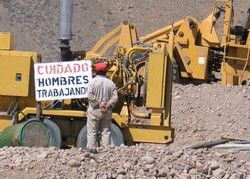 Hombres Trabajando Cuidado! Attention
men at work! Hombres Trabajando Cuidado! Attention
men at work! |
| |
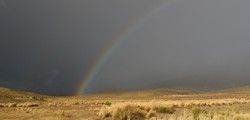 Thunderstorm: Actually, wants to fill in we even today
in Challapata our stores of water and exchange, finally, money,
however, 3 km before Challapata we are stopped by a gigantic
thunderstorm with Hagel and properly a lot of rain and can just still
creep away on time in our tent. Behind the wall there is a small well
from Nadine then luckily some waters (rather brownishly) can get,
before the thunderstorm properly gets cracking. Thunderstorm: Actually, wants to fill in we even today
in Challapata our stores of water and exchange, finally, money,
however, 3 km before Challapata we are stopped by a gigantic
thunderstorm with Hagel and properly a lot of rain and can just still
creep away on time in our tent. Behind the wall there is a small well
from Nadine then luckily some waters (rather brownishly) can get,
before the thunderstorm properly gets cracking. |
| |
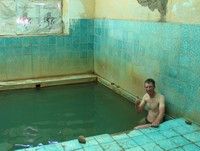 Thermal baths: In Pazña there should
be thermal baths, and thus we ask a few locals where we them then
would find. We find out that there should be here two thermal baths.
Next on the street to the north and another with the name Urizza
in the other direction. The thermal bath Urizza should be the nicer
one and thus we follow the advice of the Bolivians. Like himself then,
nevertheless, puts outside the thermal bath of Urizza 6 km lies outside
from Pazña namely of a grit runway uphill after behind a small place.
The thermal bath of Urizza belongs to a mine and a mine worker with
yellow protective helmet assigns our own bath in a little bit ramshackle
building to us. Nevertheless, differently than in other thermal baths
the sense seems here to be to be able to wash sometimes with warm
water because to use in spite of signs no shampoo some Schampootüten
lie around here. We rush in the floods and enjoy the nice hot water
to us, finally, completely schrumpelige skin have. Almost we would
have even forgotten to pay, because the mine worker with no tone has
mentioned an entry fee and the arrangement also worked rather in such
a way, as if she was intended for the mine workers and their families.
Also when we we of the mine worker dismiss he still says nothing,
however, as us hard waving over again in him drive past suddenly occurs
to him that he has forgotten what. Thermal baths: In Pazña there should
be thermal baths, and thus we ask a few locals where we them then
would find. We find out that there should be here two thermal baths.
Next on the street to the north and another with the name Urizza
in the other direction. The thermal bath Urizza should be the nicer
one and thus we follow the advice of the Bolivians. Like himself then,
nevertheless, puts outside the thermal bath of Urizza 6 km lies outside
from Pazña namely of a grit runway uphill after behind a small place.
The thermal bath of Urizza belongs to a mine and a mine worker with
yellow protective helmet assigns our own bath in a little bit ramshackle
building to us. Nevertheless, differently than in other thermal baths
the sense seems here to be to be able to wash sometimes with warm
water because to use in spite of signs no shampoo some Schampootüten
lie around here. We rush in the floods and enjoy the nice hot water
to us, finally, completely schrumpelige skin have. Almost we would
have even forgotten to pay, because the mine worker with no tone has
mentioned an entry fee and the arrangement also worked rather in such
a way, as if she was intended for the mine workers and their families.
Also when we we of the mine worker dismiss he still says nothing,
however, as us hard waving over again in him drive past suddenly occurs
to him that he has forgotten what. |
| |
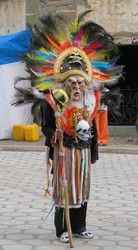 Festival in Pazña: Fresh washed we come
just on time back to Pazña around a festival move are present to skill
which just takes place here. Pazña lies about 80 km to the south of
Oruro which is famous for his carnival and in particular for
the costly and imposing masks. Apparently some groups from Oruro have
also come here, many of the absolutely impressive masks could come
just as well from a star War Film. Festival in Pazña: Fresh washed we come
just on time back to Pazña around a festival move are present to skill
which just takes place here. Pazña lies about 80 km to the south of
Oruro which is famous for his carnival and in particular for
the costly and imposing masks. Apparently some groups from Oruro have
also come here, many of the absolutely impressive masks could come
just as well from a star War Film. |
| |
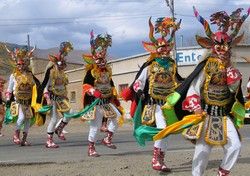 Dance groups: During just two hours we
admire the move, the coloured activity and the wild dances. On the
marketplace a big rostrum is built up on one jury sits which values
the dance presentations of the single groups. In the late afternoon
we see all at once in the horizon again drawing up thick storm clouds
and get on the way as soon as possible again. Then on the Rau's way
we hit not only on even other dance groups which just prepare themselves
but directly behind the place on the other thermal bath in a nice
relatively new building. Dance groups: During just two hours we
admire the move, the coloured activity and the wild dances. On the
marketplace a big rostrum is built up on one jury sits which values
the dance presentations of the single groups. In the late afternoon
we see all at once in the horizon again drawing up thick storm clouds
and get on the way as soon as possible again. Then on the Rau's way
we hit not only on even other dance groups which just prepare themselves
but directly behind the place on the other thermal bath in a nice
relatively new building. |
| |
225. Weekly report 17.09. - 23.09.2007
Route: Oruro, El Alto, La |
| |
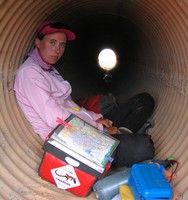 Wind and rain protection: For it that the
rainy season only in November should start we here richly many thunderstorms.
Against the rain and the always stormy north wind only the escape
sometimes helps in the street passage pipes. Wind and rain protection: For it that the
rainy season only in November should start we here richly many thunderstorms.
Against the rain and the always stormy north wind only the escape
sometimes helps in the street passage pipes. |
| |
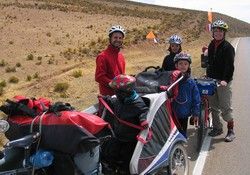 A family on bikes: Between Oruro and La
Paz we hit on Jacqueline, Pierre, Jeanna, Louis and Matthieu, a French
family on one-year-old bicycle world trip. While Jeanna and Louis
alternately with mummy on the tandem or only on a child wheel (with
luggage pockets!) cycle it enjoys Matthieu of dad in the bicycle follower
by the world to be driven. The complete tent equipment is, by the
way, also with aboard. Quite proudly tells us Jeanna that they cycle
here on the Altiplano in Bolivia daily about 70 km. We are impressed,
we have created the last days always just 45 km (Nadine had strong
stomach problems and the headwind was also not helpful). Then from
Bolivia the family further cycles over Argentina to Puerto Montt in
Chile. From South America it should go in January, 2008 then further
after New Zealand. A family on bikes: Between Oruro and La
Paz we hit on Jacqueline, Pierre, Jeanna, Louis and Matthieu, a French
family on one-year-old bicycle world trip. While Jeanna and Louis
alternately with mummy on the tandem or only on a child wheel (with
luggage pockets!) cycle it enjoys Matthieu of dad in the bicycle follower
by the world to be driven. The complete tent equipment is, by the
way, also with aboard. Quite proudly tells us Jeanna that they cycle
here on the Altiplano in Bolivia daily about 70 km. We are impressed,
we have created the last days always just 45 km (Nadine had strong
stomach problems and the headwind was also not helpful). Then from
Bolivia the family further cycles over Argentina to Puerto Montt in
Chile. From South America it should go in January, 2008 then further
after New Zealand. |
| |
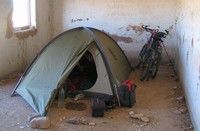 Sandstorm: Briefly after we have met the French family
we get all at once in a taut thunderstorm with sandy storm and get
just still on time to us to flee in a desolate house before outdoors
the end of the world mood starts. Though shortly before sundown the
weather has calmed down again, however, we decide to spend the night
here in the house. Sandstorm: Briefly after we have met the French family
we get all at once in a taut thunderstorm with sandy storm and get
just still on time to us to flee in a desolate house before outdoors
the end of the world mood starts. Though shortly before sundown the
weather has calmed down again, however, we decide to spend the night
here in the house. |
| |
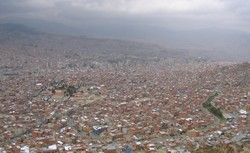 La Paz: Though La Paz is with
3600 m - 4000 m the höchstgelegene capital of the world, however,
this alone is not yet everything. La Paz lies because in the middle
of a gigantic canyon 6000th last in the horizon snowy lie. "The peace"
is called La Paz, by the way. We approach from the south the town
and the first sight in the sea from houses is really breathtaking!
However, now one means first of all from the canyon edge situated
on 4000 m down to cycle in the city centre. We would enjoy the departure
still even more if we did not know that we would have to go here again
high. Then in the town itself rules the charming swarm and chaos which
we already know from South-East Asia, however, around something more
comfortably. Here after the chaotic and loud cities in Argentina and
Chile we feel right away very well. La Paz: Though La Paz is with
3600 m - 4000 m the höchstgelegene capital of the world, however,
this alone is not yet everything. La Paz lies because in the middle
of a gigantic canyon 6000th last in the horizon snowy lie. "The peace"
is called La Paz, by the way. We approach from the south the town
and the first sight in the sea from houses is really breathtaking!
However, now one means first of all from the canyon edge situated
on 4000 m down to cycle in the city centre. We would enjoy the departure
still even more if we did not know that we would have to go here again
high. Then in the town itself rules the charming swarm and chaos which
we already know from South-East Asia, however, around something more
comfortably. Here after the chaotic and loud cities in Argentina and
Chile we feel right away very well. |
| |
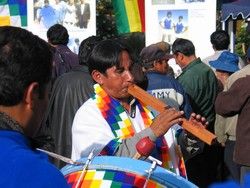 Nobel peace prize for Evo Morales:
On the 20th of September is on the Plaza de Murillo all at once a
big crowd. It plays the military marches chapel of the Bolivianischen
navy (although Bolivia has no access to the sea) and an indigene flute
group. The event is valid for the nomination of the bolivianischen
president Evo Morales for the Nobel peace prize in 2007. Evo Morales
is the first president of Bolivia from the group of the Indigenen
population comes and was chosen in 2006. Although internationally
a little bit controversially he enjoys in Bolivia a very high respect,
because the old traditions and the protection of the nature lie to
him very much with the heart and he tried the living conditions of
the easy villagers to improve. Nobel peace prize for Evo Morales:
On the 20th of September is on the Plaza de Murillo all at once a
big crowd. It plays the military marches chapel of the Bolivianischen
navy (although Bolivia has no access to the sea) and an indigene flute
group. The event is valid for the nomination of the bolivianischen
president Evo Morales for the Nobel peace prize in 2007. Evo Morales
is the first president of Bolivia from the group of the Indigenen
population comes and was chosen in 2006. Although internationally
a little bit controversially he enjoys in Bolivia a very high respect,
because the old traditions and the protection of the nature lie to
him very much with the heart and he tried the living conditions of
the easy villagers to improve. |
| |
|
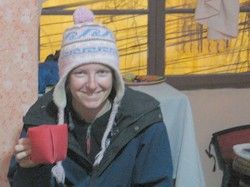 Lausers on tour: After a little bit more than
four years we meet Nicki and Gerhard again. We have met both Austrian
cyclists between Vienna and Bratislava and have looked then together
for a camp site. At that time Nicki and Gerhard have used her vacations
to cycle in two months to Damascus. The both could conclude their
teaching post study just still successfully, before they were packed
again seriously by the Radelfieber. Now for meanwhile two years
they are on the way from Alaska to Tierra del Fuego. Of course there
is to tell a lot and thus we rattle half a night through before
we always through deserted lanes again in our Hostel return. Although
we nearly one week together here have spent we have not got, nevertheless,
unfortunately, on the row to make a reasonable picture of the both
(sorry). Lausers on tour: After a little bit more than
four years we meet Nicki and Gerhard again. We have met both Austrian
cyclists between Vienna and Bratislava and have looked then together
for a camp site. At that time Nicki and Gerhard have used her vacations
to cycle in two months to Damascus. The both could conclude their
teaching post study just still successfully, before they were packed
again seriously by the Radelfieber. Now for meanwhile two years
they are on the way from Alaska to Tierra del Fuego. Of course there
is to tell a lot and thus we rattle half a night through before
we always through deserted lanes again in our Hostel return. Although
we nearly one week together here have spent we have not got, nevertheless,
unfortunately, on the row to make a reasonable picture of the both
(sorry).
|
| |
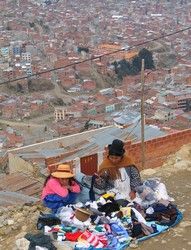 Market in El Alto: On Sunday it high goes
on the weekly market of El Alto visit on top in the canyon edge we
together with Nicki and Gerhard. The situation of the market along
a railroad track directly in the canyon edge is magnificent! Although
we had been warned before already several times as dangerously the
market should be up here we feel very well. The market women are incredibly
charming and it gives incredibly a lot of pleasure to stroll here
above the market on it of used things about the newest pirated copy
of American music groups nearly everything gives what the heart popularly
and to maintain us with the people. Market in El Alto: On Sunday it high goes
on the weekly market of El Alto visit on top in the canyon edge we
together with Nicki and Gerhard. The situation of the market along
a railroad track directly in the canyon edge is magnificent! Although
we had been warned before already several times as dangerously the
market should be up here we feel very well. The market women are incredibly
charming and it gives incredibly a lot of pleasure to stroll here
above the market on it of used things about the newest pirated copy
of American music groups nearly everything gives what the heart popularly
and to maintain us with the people. |
| |
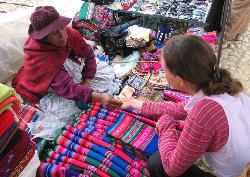 El Cargador: Then at last Nadine also buys one bolivianischen
Tragetücher of the women. Although presumably, actually, only to the
transport of the babies thought heard such a Tragetuch to the compulsory
clothing piece of the bolivianischen women. Though to us it is a riddle
why, however, something seem the Bolivianerinnen always to lug to
have. At least fits into such a Cargador, nevertheless, a little bit
more than in your average European ladies' handbag.:-) El Cargador: Then at last Nadine also buys one bolivianischen
Tragetücher of the women. Although presumably, actually, only to the
transport of the babies thought heard such a Tragetuch to the compulsory
clothing piece of the bolivianischen women. Though to us it is a riddle
why, however, something seem the Bolivianerinnen always to lug to
have. At least fits into such a Cargador, nevertheless, a little bit
more than in your average European ladies' handbag.:-) |
| |
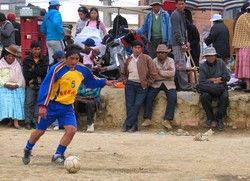 Football game: the middle of the market
in El Alto is at once a small football pitch on just one lot on the
run. Even with much wohlwollen can the space only describe as bad,
but fortunately pays tribute to the very strict referee the space
is no bill by rough play tolerate. Behind one Fußballtor there is
a small dump, while on the other side directly market stalls. During
the already abundant ramponierte ball often between the market stalls
once land is even an older market Besucherin fully wounded. Somehow
reminded the football game kleinwenig to the football game on the
market in the German movie WERNER: Football game: the middle of the market
in El Alto is at once a small football pitch on just one lot on the
run. Even with much wohlwollen can the space only describe as bad,
but fortunately pays tribute to the very strict referee the space
is no bill by rough play tolerate. Behind one Fußballtor there is
a small dump, while on the other side directly market stalls. During
the already abundant ramponierte ball often between the market stalls
once land is even an older market Besucherin fully wounded. Somehow
reminded the football game kleinwenig to the football game on the
market in the German movie WERNER: |
| |
226. Weekly report 24.09. - 30/09/2007
Route: La Paz |
| |
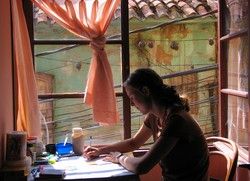 Spanish course: In an other attempt to
improve our Spanish knowledge here we make in La Paz a Spanish course.
Because we have learnt in Buenos Aires substantially more during the
single hours than during the group hours this time we turn to an independent
Spanish teacher, however, unfortunately, with low success. Over and
over again we must find out because by the remachining that our teacher
has completely wrong explained to us some grammar rules or has sorted
verbs into the wrong Verbguppen. When we she comes appealing as a
result only to one flood of excuses. After a while we find out that
our teacher belongs to the witnesses of Jehovah and thus becomes clear
to us at least, why we always talk about so funny subjects during
our Spanish hours (The meaning of the Bible...) . Thus I get as a
gift as a Spanish reading a "watch-tower". Moreover, we are invited
to a congress of the witnesses of Jehovah here in La Paz. Because
of the congress our last both teaching hours then also in the late
evening instead of with the success that find the teacher several
times in with me the lessons falls asleep. She dictates the grammar
rules to the Subjuntivo (a special verb form in the Spanish) to me
then also directly from a book before. However, there she also, besides,
several times drops off, nevertheless, the rules prove no sense. Spanish course: In an other attempt to
improve our Spanish knowledge here we make in La Paz a Spanish course.
Because we have learnt in Buenos Aires substantially more during the
single hours than during the group hours this time we turn to an independent
Spanish teacher, however, unfortunately, with low success. Over and
over again we must find out because by the remachining that our teacher
has completely wrong explained to us some grammar rules or has sorted
verbs into the wrong Verbguppen. When we she comes appealing as a
result only to one flood of excuses. After a while we find out that
our teacher belongs to the witnesses of Jehovah and thus becomes clear
to us at least, why we always talk about so funny subjects during
our Spanish hours (The meaning of the Bible...) . Thus I get as a
gift as a Spanish reading a "watch-tower". Moreover, we are invited
to a congress of the witnesses of Jehovah here in La Paz. Because
of the congress our last both teaching hours then also in the late
evening instead of with the success that find the teacher several
times in with me the lessons falls asleep. She dictates the grammar
rules to the Subjuntivo (a special verb form in the Spanish) to me
then also directly from a book before. However, there she also, besides,
several times drops off, nevertheless, the rules prove no sense. |
| |
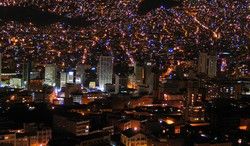 Guitar lessons: However, here not only
to my Spanish knowledge I have granted in La Paz an improvement. Here
thanks to costs for one teaching hour of 3$ of US I have also afforded
a few guitar hours. Ramirez of the Bolivians with the quickest debate
in completely La Paz has seen it on my clumsy fingers. Thanks to the
exercises he allows to make me I after every hour immediately several
knots in my fingers and substantially muscular strain in the forearms,
however, after a few days everything catches itself something to loosen
and we play together a few easy songs. Guitar lessons: However, here not only
to my Spanish knowledge I have granted in La Paz an improvement. Here
thanks to costs for one teaching hour of 3$ of US I have also afforded
a few guitar hours. Ramirez of the Bolivians with the quickest debate
in completely La Paz has seen it on my clumsy fingers. Thanks to the
exercises he allows to make me I after every hour immediately several
knots in my fingers and substantially muscular strain in the forearms,
however, after a few days everything catches itself something to loosen
and we play together a few easy songs. |
| |
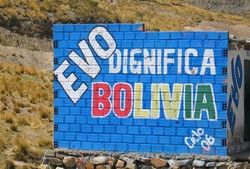 Demonstrations: The democracy in Bolivia
is just 25 years old and the Bolivians are engaged accordingly. Demonstrations
with street blockades they have run in the agenda and there, actually,
peacefully nobody also further takes exception to it. All demonstrations
we have seen upwards the demonstrators to a few shields with her demand
resembled rather a comfortable chat on the street with held. Merely
with a smaller crowd before the court the demonstrating women have
supported her demands for more justice still with loud slogans. Demonstrations: The democracy in Bolivia
is just 25 years old and the Bolivians are engaged accordingly. Demonstrations
with street blockades they have run in the agenda and there, actually,
peacefully nobody also further takes exception to it. All demonstrations
we have seen upwards the demonstrators to a few shields with her demand
resembled rather a comfortable chat on the street with held. Merely
with a smaller crowd before the court the demonstrating women have
supported her demands for more justice still with loud slogans. |
| |
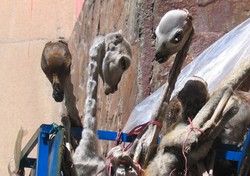 Healer's market: In La Paz there is a so-called "witch's
market" well to the model for some scenes with Harry Potter could
have worked as a model. "Superstition" is coined in Bolivia still
very much and here thus there are the most wondrous things to shop.
Thus there are bath products the ideal partner in addition should
bring themselves in one to fall in love if one recites into the bargain
some father ours, or lead perfumes to prosperity. Then, nevertheless,
a little bit very unusual for us the llama foetuses offered for the
sales one are, for example, about the Türe knocks. However, besides
there is also a woman the all kinds of herbs sold and there I just
some open places in the mouth has here we can buy some sage one looks
in the chemist's shops in vain. Healer's market: In La Paz there is a so-called "witch's
market" well to the model for some scenes with Harry Potter could
have worked as a model. "Superstition" is coined in Bolivia still
very much and here thus there are the most wondrous things to shop.
Thus there are bath products the ideal partner in addition should
bring themselves in one to fall in love if one recites into the bargain
some father ours, or lead perfumes to prosperity. Then, nevertheless,
a little bit very unusual for us the llama foetuses offered for the
sales one are, for example, about the Türe knocks. However, besides
there is also a woman the all kinds of herbs sold and there I just
some open places in the mouth has here we can buy some sage one looks
in the chemist's shops in vain. |
| |
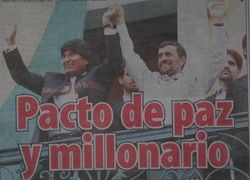 State visit: I run just thus from my guitar
hour home when I see everywhere really a lot of police and note on
the Plaza Murijjo a small crowd. I interfere under the people before
the government palace is around on somebody to wait. I am there just
a few minutes when the balcony doors rise on the first floor and kick
Evo Morales, the bolivianische president, with his guest to the Iranian
president Mahmud Ahmadinejad before the people. The amount rejoices
and, finally, both presidents collect themselves in the hands and
stretch them confident of victory upwards. After a few minutes stretch
the presidents who are called by the press most near days confidentially
Evo and Mahmud, back to devote themselves to the state shops. Although
Mahmud Ahmadinejad only 5 hours in La Paz signs stayed he with Evo
Morales contracts, the Iranian investments in Bolivia at a height
of 1100 million. $US guarantee as I infer the next day from the local
newspaper. However, besides both heads of state also explain that
they want to walk on a way of the peace and that they want to pursue
nuclear programmes merely to the peaceful use (a rather one-sided
explanation thinks, nevertheless is, because I have never heard what
of bolivianischen nuclear programmes). Further explains the Iranian
president: "Quiero anunciar en voz alta que nosotros, tamados de
las manos, vamos a construir nuestras sagradas tierras, erradicamremos
la pobreza y llevaremos a nuestros pueblos a la paz"... "los dos pueblos
(Bolivia y Iran), en el camino de sus altas ideas, salrdán victoriosamente".
("I want to explain with nothing but voice that we, in the hands
taking, our holy countries are based that we will exterminate the
poverty and will carry our people to the peace,"..." two people, on
the way of her high ideas, will be victorious".) State visit: I run just thus from my guitar
hour home when I see everywhere really a lot of police and note on
the Plaza Murijjo a small crowd. I interfere under the people before
the government palace is around on somebody to wait. I am there just
a few minutes when the balcony doors rise on the first floor and kick
Evo Morales, the bolivianische president, with his guest to the Iranian
president Mahmud Ahmadinejad before the people. The amount rejoices
and, finally, both presidents collect themselves in the hands and
stretch them confident of victory upwards. After a few minutes stretch
the presidents who are called by the press most near days confidentially
Evo and Mahmud, back to devote themselves to the state shops. Although
Mahmud Ahmadinejad only 5 hours in La Paz signs stayed he with Evo
Morales contracts, the Iranian investments in Bolivia at a height
of 1100 million. $US guarantee as I infer the next day from the local
newspaper. However, besides both heads of state also explain that
they want to walk on a way of the peace and that they want to pursue
nuclear programmes merely to the peaceful use (a rather one-sided
explanation thinks, nevertheless is, because I have never heard what
of bolivianischen nuclear programmes). Further explains the Iranian
president: "Quiero anunciar en voz alta que nosotros, tamados de
las manos, vamos a construir nuestras sagradas tierras, erradicamremos
la pobreza y llevaremos a nuestros pueblos a la paz"... "los dos pueblos
(Bolivia y Iran), en el camino de sus altas ideas, salrdán victoriosamente".
("I want to explain with nothing but voice that we, in the hands
taking, our holy countries are based that we will exterminate the
poverty and will carry our people to the peace,"..." two people, on
the way of her high ideas, will be victorious".) |
| |
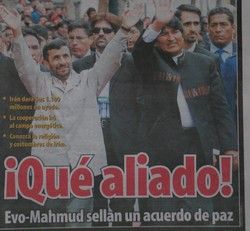 Qué aliado: What an ally. While Bolivia is grateful
for every economic support, the Iranian president seems to look for
international backing in his nuclear quarrel with the USA. According
to newspaper reports both presidents have got on so well that they
have immediately embraced several times. Very interesting I thought
that the next day was reported in several articles not only in detail
about the meeting of the heads of state , but also Iran, his culture
and his religion were shown extensively. Nevertheless, with all joy
at the economically help the reporters have not forgotten it that
the situation of the women is improvement-worthy in Iran absolutely
and the mismanagement in some article also clearly named. The sight
of Morales and Ahmadinejad like they sure of victory her calm hands
heavenward stretch, nevertheless, has tuned not only me thoughtfully.
The both are, by the way, the first heads of state I from the next
nearness sees. Qué aliado: What an ally. While Bolivia is grateful
for every economic support, the Iranian president seems to look for
international backing in his nuclear quarrel with the USA. According
to newspaper reports both presidents have got on so well that they
have immediately embraced several times. Very interesting I thought
that the next day was reported in several articles not only in detail
about the meeting of the heads of state , but also Iran, his culture
and his religion were shown extensively. Nevertheless, with all joy
at the economically help the reporters have not forgotten it that
the situation of the women is improvement-worthy in Iran absolutely
and the mismanagement in some article also clearly named. The sight
of Morales and Ahmadinejad like they sure of victory her calm hands
heavenward stretch, nevertheless, has tuned not only me thoughtfully.
The both are, by the way, the first heads of state I from the next
nearness sees.
|
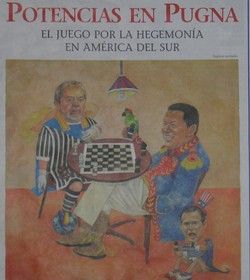 South America wakes: South America stirs,
and after the wild years of the military dictatorships (for the time
being) are overcome themselves widespread with growing democratisation
also the wish for more independence and international influence. At
least in this sense I interpret the foundation of MERCOSUR, an economic
cooperation of the South American states (how once the European Economic
Community). Further one plans to reach the foundation of a "bank of
the south" around more independence from the world bank. In particular
the radical venezuelanische president Hugo Chávaez (by Bolivia, Equador
and Argentina in the back) and the temperate Brazilian president Luiz
Ignázio Lula there Silva (with Peru, Uruguay, Paraguay and Chile on
his side) do South America in a new direction. Brazil aims even at
a constant seat in the security council of UN during itself Hugo Chávez
the political compromises of his allies buys (the helicopters during
the visit of the Iranian president over La Paz circled is a loan of
Cháves). Interesting with the caricature the "new" role is also those
of the artists for the USA sees: While Lula and Chávez around the
hegemony in South America play the USA sit off the real events and
deal with Colombia. South America wakes: South America stirs,
and after the wild years of the military dictatorships (for the time
being) are overcome themselves widespread with growing democratisation
also the wish for more independence and international influence. At
least in this sense I interpret the foundation of MERCOSUR, an economic
cooperation of the South American states (how once the European Economic
Community). Further one plans to reach the foundation of a "bank of
the south" around more independence from the world bank. In particular
the radical venezuelanische president Hugo Chávaez (by Bolivia, Equador
and Argentina in the back) and the temperate Brazilian president Luiz
Ignázio Lula there Silva (with Peru, Uruguay, Paraguay and Chile on
his side) do South America in a new direction. Brazil aims even at
a constant seat in the security council of UN during itself Hugo Chávez
the political compromises of his allies buys (the helicopters during
the visit of the Iranian president over La Paz circled is a loan of
Cháves). Interesting with the caricature the "new" role is also those
of the artists for the USA sees: While Lula and Chávez around the
hegemony in South America play the USA sit off the real events and
deal with Colombia. |
| |
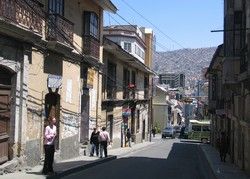 Do not lie, do not steal not be decayed:
The Inca's right: Like us our Spanish teacher told is valid in
some regions of Bolivia still the old Inca's right with the motto:
Do not lie, do not steal not be decayed. Nevertheless, hardly we can
believe ourselves as them told that, therefore, e.g., with thieves
short action is brought and they are simply burnt. Then a few days
later we hit on two Argentines whom in a store with try on from things
the photo had been stolen. Immediately the store employees and the
mob wanted to pull the woman suspected for the theft to the account,
and only by the intervention of both Argentines worse was prevented.
Particularly has pleased us that both Argentines have retrieved her
photo after some days and some negotiations, finally! Do not lie, do not steal not be decayed:
The Inca's right: Like us our Spanish teacher told is valid in
some regions of Bolivia still the old Inca's right with the motto:
Do not lie, do not steal not be decayed. Nevertheless, hardly we can
believe ourselves as them told that, therefore, e.g., with thieves
short action is brought and they are simply burnt. Then a few days
later we hit on two Argentines whom in a store with try on from things
the photo had been stolen. Immediately the store employees and the
mob wanted to pull the woman suspected for the theft to the account,
and only by the intervention of both Argentines worse was prevented.
Particularly has pleased us that both Argentines have retrieved her
photo after some days and some negotiations, finally! |
| |
227. Weekly report 01.10. - 07/10/2007
Route: La Paz, La Cumbre, Caranavi, Villa Florida |
| |
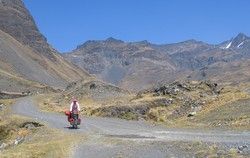 Departure from La Paz: From La Paz we want
in the direction of west in the Yungas and afterwards further to Amazonia.
However, before the big departure we have to go first of all substantially
uphill, namely from 3600 m in La Paz on 4700 m in La Cumbre. After
the time free of reprimand the increase from La Paz heavier than believed
falls to us. As usual a taut icy wind blows us at the midday again
against which makes every metre the torture, so that we whip our tent
earlier than planned in the late afternoon shortly before the passport.
The next morning then happens the almost unbelievable: I am overtaken
just by a truck as the front seat passenger exactly at this moment
the Türe opens to push me from the bicycle! I have incredibly a lot
of luck, because instead of me "merely" my rear pannier meets the
Türe, so that I come flinging only something in. Moreover, I have
the luck that at this point just no deep abyss is beside me! Although
this absolutely the most unbelievable traffic situation on our trip
was, nevertheless, it on no account reflects the relations in Bolivia
again where we are taken up by the Bolivians otherwise very warmly. Departure from La Paz: From La Paz we want
in the direction of west in the Yungas and afterwards further to Amazonia.
However, before the big departure we have to go first of all substantially
uphill, namely from 3600 m in La Paz on 4700 m in La Cumbre. After
the time free of reprimand the increase from La Paz heavier than believed
falls to us. As usual a taut icy wind blows us at the midday again
against which makes every metre the torture, so that we whip our tent
earlier than planned in the late afternoon shortly before the passport.
The next morning then happens the almost unbelievable: I am overtaken
just by a truck as the front seat passenger exactly at this moment
the Türe opens to push me from the bicycle! I have incredibly a lot
of luck, because instead of me "merely" my rear pannier meets the
Türe, so that I come flinging only something in. Moreover, I have
the luck that at this point just no deep abyss is beside me! Although
this absolutely the most unbelievable traffic situation on our trip
was, nevertheless, it on no account reflects the relations in Bolivia
again where we are taken up by the Bolivians otherwise very warmly.
|
| |
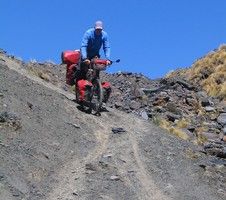 The worlds most Dangerous Road:
Because we are not sure first whether the door attack is here maybe
a quirk the truck driver, meanwhile completely irritated from the
whole cyclists we are in organised groups so-called "Death road" hinunterradeln,
2 to directly to La Cumbre on precipitous unused Schotterstrasse from.
The controlled tours drive all first 20 km on the tarred road up to
the real putting on one side of the infamous most dangerous street
of the world down in the Yungas. Nevertheless, the upper part is presumably
too demanding to the groups technically, nevertheless, it is a matter
of overcoming some brooks and Steilhänge. We have with our treacly
loaded wheels, nevertheless, no serious problems and enjoy the marvellous
lonesome and car free scenery in full trains. The worlds most Dangerous Road:
Because we are not sure first whether the door attack is here maybe
a quirk the truck driver, meanwhile completely irritated from the
whole cyclists we are in organised groups so-called "Death road" hinunterradeln,
2 to directly to La Cumbre on precipitous unused Schotterstrasse from.
The controlled tours drive all first 20 km on the tarred road up to
the real putting on one side of the infamous most dangerous street
of the world down in the Yungas. Nevertheless, the upper part is presumably
too demanding to the groups technically, nevertheless, it is a matter
of overcoming some brooks and Steilhänge. We have with our treacly
loaded wheels, nevertheless, no serious problems and enjoy the marvellous
lonesome and car free scenery in full trains. |
| |
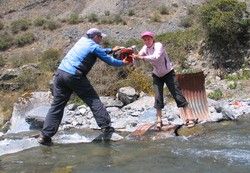 Rivercrossing: Though an older farmer still
gives us the tip that we should keep after the next bridge on the
left, however, anyhow we miss the putting on one side and land, finally,
before a bigger brook without bridge. Now one means to unload everything
and to carry on the other side, however, without falling, besides,
in the chill Wet what is not so easy on the slippery stones, nevertheless,
at all. Rivercrossing: Though an older farmer still
gives us the tip that we should keep after the next bridge on the
left, however, anyhow we miss the putting on one side and land, finally,
before a bigger brook without bridge. Now one means to unload everything
and to carry on the other side, however, without falling, besides,
in the chill Wet what is not so easy on the slippery stones, nevertheless,
at all. |
| |
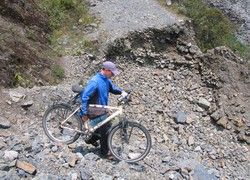 Landslide: We further follow the grit runway running
in parallel with the tarred street and land in such a way, after we
have crossed some idyllic villages, directly before a landslide. If
we were by a car on the way now we would have to turn round, however,
thus we simply unload our wheels again and carry our equipment on
the other side. I just still carry as the last Nadines bicycle about
the loose stone as sudden a big stone gives way and with him all at
once "half a slope" in slide gets. I lie quick on the nose as myself
is dear and can just still prevent from slipping off further. Thanks
to Nadines the help which takes the wheel from me I come again back
on firm ground and, finally, certainly on the other side. Landslide: We further follow the grit runway running
in parallel with the tarred street and land in such a way, after we
have crossed some idyllic villages, directly before a landslide. If
we were by a car on the way now we would have to turn round, however,
thus we simply unload our wheels again and carry our equipment on
the other side. I just still carry as the last Nadines bicycle about
the loose stone as sudden a big stone gives way and with him all at
once "half a slope" in slide gets. I lie quick on the nose as myself
is dear and can just still prevent from slipping off further. Thanks
to Nadines the help which takes the wheel from me I come again back
on firm ground and, finally, certainly on the other side. |
| |
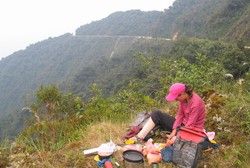 Camping on the most dangerous street
of the world: Differently than the controlled tours, for the regional
magnificent distance just some stood time have we dispose well over
that and whip so early in the evening our tent in a stone quarry situated
in the street. Then, nevertheless, to the dinner we sit down over
again to the wayside around the though hazy scenery impressive however
nevertheless to enjoy. Camping on the most dangerous street
of the world: Differently than the controlled tours, for the regional
magnificent distance just some stood time have we dispose well over
that and whip so early in the evening our tent in a stone quarry situated
in the street. Then, nevertheless, to the dinner we sit down over
again to the wayside around the though hazy scenery impressive however
nevertheless to enjoy. |
| |
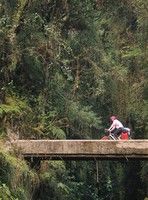 Primeval forest: The further
we downhill in the Yungas cycle the closer and more wildly becomes
the plant world and after we have cycled the day before still by scanty
high valleys now we are, only few kilometres later, in the thick primeval
forest. Primeval forest: The further
we downhill in the Yungas cycle the closer and more wildly becomes
the plant world and after we have cycled the day before still by scanty
high valleys now we are, only few kilometres later, in the thick primeval
forest. |
| |
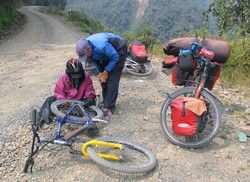 Guided bicycle tours on "Death Road":
Although we a total of 2 days on the famous tourist wheel distance
are we have found, because we have avoided the tarred road in the
upper part, on the way only one only ones controlled group. First
we are still overtaken by the group, however, later we meet a few
curves all at once again one of the guides. His wheel pushing! We
ask for his problem, and he means he would have records, however,
no air pump! We have already belonged a lot from the controlled bicycle
tours here, however that the guide an air pump not even has including
we find really very wittily. We help out him with our air pump and
a few minutes later he proceeds on the chase to his group. We make
just break on a small Ausbuchtung as the escort vehicle of the bicycle
group comes (they have also got a pump, besides) and us in recognition
of our help an occupied cheese bread roll and a few bananas handed!
The group we have met was on the move rather quietly and well-behaved
(with a guide at the group beginning and at the end), however, in
principle we have heard there rather another stories. Though the street
is put out here and there very much and the deep abysses are already
erfurchtserweckend, however, as dangerous we have felt the street
by no means. At least since the new tarred road was opened the last
year there is hardly more truck and coach traffic which has made the
narrow street absolutely around something more adventurous. Here,
nevertheless, tourists have a fatal accident as a participant of controlled
bicycle tours (they simply fall about an abyss). Cause would be allowed
to do here, nevertheless, rather banked speed, inexperienced cyclists
to itself overestimate and guides them her customers to too quick
cycling animate be as the "dangerous street". Actually, accidents
are no miracle if we find out from a guide that them the distance
for we 1.5 days have used in 1.5 - 3 hours cycle! To enjoy a lot of
time around the scenery and to take photos, besides, does not remain,
in any case. Apart from the fact the one or other fallen tourist raises
also the ostensible danger and therefore the charm of the tour and
consequently also the business! Guided bicycle tours on "Death Road":
Although we a total of 2 days on the famous tourist wheel distance
are we have found, because we have avoided the tarred road in the
upper part, on the way only one only ones controlled group. First
we are still overtaken by the group, however, later we meet a few
curves all at once again one of the guides. His wheel pushing! We
ask for his problem, and he means he would have records, however,
no air pump! We have already belonged a lot from the controlled bicycle
tours here, however that the guide an air pump not even has including
we find really very wittily. We help out him with our air pump and
a few minutes later he proceeds on the chase to his group. We make
just break on a small Ausbuchtung as the escort vehicle of the bicycle
group comes (they have also got a pump, besides) and us in recognition
of our help an occupied cheese bread roll and a few bananas handed!
The group we have met was on the move rather quietly and well-behaved
(with a guide at the group beginning and at the end), however, in
principle we have heard there rather another stories. Though the street
is put out here and there very much and the deep abysses are already
erfurchtserweckend, however, as dangerous we have felt the street
by no means. At least since the new tarred road was opened the last
year there is hardly more truck and coach traffic which has made the
narrow street absolutely around something more adventurous. Here,
nevertheless, tourists have a fatal accident as a participant of controlled
bicycle tours (they simply fall about an abyss). Cause would be allowed
to do here, nevertheless, rather banked speed, inexperienced cyclists
to itself overestimate and guides them her customers to too quick
cycling animate be as the "dangerous street". Actually, accidents
are no miracle if we find out from a guide that them the distance
for we 1.5 days have used in 1.5 - 3 hours cycle! To enjoy a lot of
time around the scenery and to take photos, besides, does not remain,
in any case. Apart from the fact the one or other fallen tourist raises
also the ostensible danger and therefore the charm of the tour and
consequently also the business! |
| |
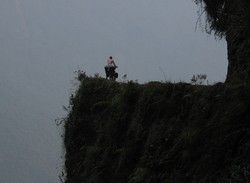 Abysses and narrow places: Some of the
abysses and narrow places on the WMDR (worlds most dangerous road)
are really breathtaking and also the reason for the "legendary call"
of the distance. Unfortunately, just these places too often became
the Lkws and coaches the disaster which have tried here each other
vorbeizuzwängen. According to a sign with a check post 16 people on
the distance should have had a fatal accident last year; under it
also two tourists. Abysses and narrow places: Some of the
abysses and narrow places on the WMDR (worlds most dangerous road)
are really breathtaking and also the reason for the "legendary call"
of the distance. Unfortunately, just these places too often became
the Lkws and coaches the disaster which have tried here each other
vorbeizuzwängen. According to a sign with a check post 16 people on
the distance should have had a fatal accident last year; under it
also two tourists.
|
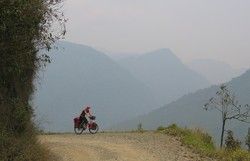 The US Bolivian: Then shortly after Ya
the old street hits again on the new tarred road and for a few restful
kilometres there remains tarred, even if it is to us a riddle why
in the places instead of tar cobblestones lies (maybe the tar was
too quiet to the local residents). The tar is preserved to us only
briefly and all of a sudden we find ourselves again on a dust runway.
We have set off meanwhile from 4700 m up to about 1100 m and in addition
to the dust comes a muggy heat unusual for us. In the late afternoon
we are demanded all at once into perfect American English. Juan and
Jenny (a bolivianisch Argentine pair) live, actually, in New York,
however because he here from the Yungas comes they come to make for
a few years over and over again here back around vacation. Besides,
at the moment they are here in the place in he has grown up a property
to acquire to be founded a nice small house to enjoy the old age here
(in each case half a year here and half a year in the USA) later.
Juan tells us that there was here earlier hardly dust, because the
street was covered partially still with grass, however, sometime the
government left grit from the Altiplano to improve the street and
here since then everything would be so dusty. However, a little further
below the street, because where they want to build her house, it would
not be so bad completely. Here apart from the fact his now thanks
to financial support from Germany the plans for continuing of the
tarred road under roof and field and in 12 months the dust would belong
to the history. We question Juan something else about the bolivianischen
president and although he does not like it though that he with Hugo
Cháves so much under a cover puts told he us that Morales makes good
otherwise his thing very much. Differently than presumably all the
other presidents of the world Morales has halved his salary after
assumption of office first of all and has also shortened the walking
age of the parliamentarians! On the occasion of the earthquake few
weeks ago in Peru Morales has donated immediately half of his salary
to the earthquake victims and to touch his ministers in addition stopped
him and to donate at least 25% of the yours. The US Bolivian: Then shortly after Ya
the old street hits again on the new tarred road and for a few restful
kilometres there remains tarred, even if it is to us a riddle why
in the places instead of tar cobblestones lies (maybe the tar was
too quiet to the local residents). The tar is preserved to us only
briefly and all of a sudden we find ourselves again on a dust runway.
We have set off meanwhile from 4700 m up to about 1100 m and in addition
to the dust comes a muggy heat unusual for us. In the late afternoon
we are demanded all at once into perfect American English. Juan and
Jenny (a bolivianisch Argentine pair) live, actually, in New York,
however because he here from the Yungas comes they come to make for
a few years over and over again here back around vacation. Besides,
at the moment they are here in the place in he has grown up a property
to acquire to be founded a nice small house to enjoy the old age here
(in each case half a year here and half a year in the USA) later.
Juan tells us that there was here earlier hardly dust, because the
street was covered partially still with grass, however, sometime the
government left grit from the Altiplano to improve the street and
here since then everything would be so dusty. However, a little further
below the street, because where they want to build her house, it would
not be so bad completely. Here apart from the fact his now thanks
to financial support from Germany the plans for continuing of the
tarred road under roof and field and in 12 months the dust would belong
to the history. We question Juan something else about the bolivianischen
president and although he does not like it though that he with Hugo
Cháves so much under a cover puts told he us that Morales makes good
otherwise his thing very much. Differently than presumably all the
other presidents of the world Morales has halved his salary after
assumption of office first of all and has also shortened the walking
age of the parliamentarians! On the occasion of the earthquake few
weeks ago in Peru Morales has donated immediately half of his salary
to the earthquake victims and to touch his ministers in addition stopped
him and to donate at least 25% of the yours. |
| |
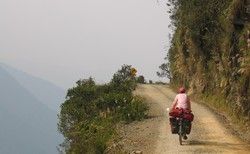 Good call: Already yesterday we were perplexed a little
bit when all members of a road construction troop have spontaneously
taken off her hats and have wished us especially warmly a good continuation
of the journey, after they had found out that we are Germans. Also
Juan reports to us that we had Germans here in Bolivia a very good
call. Not only because we financially many construction projects Supported
ones would know (as for example the new tarred road), but also because
the Germans would maintain the best schools in Bolivia (a little bit
we already from Uruguay) and with factories them would establish the
economic power of Bolivia would strengthen. We would not least bring
as tourists also a lot of money in the country. Good call: Already yesterday we were perplexed a little
bit when all members of a road construction troop have spontaneously
taken off her hats and have wished us especially warmly a good continuation
of the journey, after they had found out that we are Germans. Also
Juan reports to us that we had Germans here in Bolivia a very good
call. Not only because we financially many construction projects Supported
ones would know (as for example the new tarred road), but also because
the Germans would maintain the best schools in Bolivia (a little bit
we already from Uruguay) and with factories them would establish the
economic power of Bolivia would strengthen. We would not least bring
as tourists also a lot of money in the country. |
| |
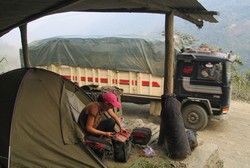 Snug camp site: After the absolutely quiet
camp site of the day before it gets us this time quite badly. The
street runs in a narrow valley and all more or less level places are
farmed. Only far after sundown we discover directly beside the street
a desolate construction ruin. So near in the street we have never
slept though, nevertheless, there are alternatives none. Not to attract
too much attention we build up our tent, nevertheless, only as it
is already completely dark. While we comes sitting just thus with
our dinner there all at once in the middle from the dark bushes a
hunter with flashlight and geschultertem gun walks and comes along
after a short greeting on the way home. Actually, we had hoped that
at night the traffic, like on all streets ordinarily would strongly
decrease, however, here it has just turned back. A truck and a coach
after the other thunder only few centimetres along our heads and there
itself here, moreover, also a passing place considers it is honked
quite often also loudly. An anything but restful night. Snug camp site: After the absolutely quiet
camp site of the day before it gets us this time quite badly. The
street runs in a narrow valley and all more or less level places are
farmed. Only far after sundown we discover directly beside the street
a desolate construction ruin. So near in the street we have never
slept though, nevertheless, there are alternatives none. Not to attract
too much attention we build up our tent, nevertheless, only as it
is already completely dark. While we comes sitting just thus with
our dinner there all at once in the middle from the dark bushes a
hunter with flashlight and geschultertem gun walks and comes along
after a short greeting on the way home. Actually, we had hoped that
at night the traffic, like on all streets ordinarily would strongly
decrease, however, here it has just turned back. A truck and a coach
after the other thunder only few centimetres along our heads and there
itself here, moreover, also a passing place considers it is honked
quite often also loudly. An anything but restful night. |
| |
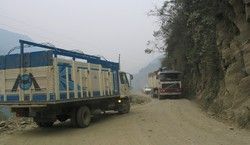 The maybe filthiest street of the
world: Last sometimes that we have been got covered in dust on
a street thus was in Cambodia and also at that time it was similarly
hot and oppressive. It is interesting, by the way, that although here
in Bolivia ordinarily right-hand traffic rules here on the narrow
narrow streets in the Yungas link traffic is prescribed. The reason
is clear, because thus the driver is in each case on the side of the
abyss and can estimate so much better as far he can venture on the
street edge. The maybe filthiest street of the
world: Last sometimes that we have been got covered in dust on
a street thus was in Cambodia and also at that time it was similarly
hot and oppressive. It is interesting, by the way, that although here
in Bolivia ordinarily right-hand traffic rules here on the narrow
narrow streets in the Yungas link traffic is prescribed. The reason
is clear, because thus the driver is in each case on the side of the
abyss and can estimate so much better as far he can venture on the
street edge. |
| |
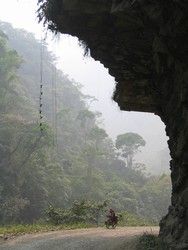 Front garden of the Amazon: The scenery
here in the front garden of the Amazon area is absolutely marvellous:
Our street winds by a wonderful valley covered with Jungle. Among
us lies a delightfully blue foot, parrots fly screamingly over our
heads away and gigantic radiant blue butterflies hang fluttering in
the air. The word is to be crept itself almost already "heavenly",
besides, in my head when a truck comes around corner and we disappear
again for fairly long time under a thick cloud of dust. Front garden of the Amazon: The scenery
here in the front garden of the Amazon area is absolutely marvellous:
Our street winds by a wonderful valley covered with Jungle. Among
us lies a delightfully blue foot, parrots fly screamingly over our
heads away and gigantic radiant blue butterflies hang fluttering in
the air. The word is to be crept itself almost already "heavenly",
besides, in my head when a truck comes around corner and we disappear
again for fairly long time under a thick cloud of dust. |
| |
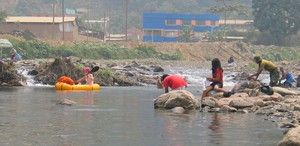 Paddle tour Rio Coroico: From Caranavi
we want to paddle over the rivers Coroico, Kaka and Beni till the
Junglestädtchen Rurennabaque in Amazonia. For weeks I have tried to
find about one in La Paz in vain we have printed out a map of the
region and at last the map being on the notice board in the tourist
information abfotografiert, and einlaminiert. The distance of Caranavi
to Rurrenabaque is difficult to estimate, however, we suppose that
it might be about 250 - 300 km. According to current we plan with
7 - to 9 days and buy accordingly food. There are on the way though
some places, however how big they are actual we do not know. Directly
before our Hostel there flows a side arm of Rio Coroico and thus we
can puff ourselves up with the help of the ventilating fan our boats
in the twinkling of an eye before we on our trip in unknown ones transferred. Paddle tour Rio Coroico: From Caranavi
we want to paddle over the rivers Coroico, Kaka and Beni till the
Junglestädtchen Rurennabaque in Amazonia. For weeks I have tried to
find about one in La Paz in vain we have printed out a map of the
region and at last the map being on the notice board in the tourist
information abfotografiert, and einlaminiert. The distance of Caranavi
to Rurrenabaque is difficult to estimate, however, we suppose that
it might be about 250 - 300 km. According to current we plan with
7 - to 9 days and buy accordingly food. There are on the way though
some places, however how big they are actual we do not know. Directly
before our Hostel there flows a side arm of Rio Coroico and thus we
can puff ourselves up with the help of the ventilating fan our boats
in the twinkling of an eye before we on our trip in unknown ones transferred. |
| |
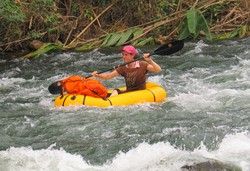 Rapids: For us our boat stages are always
to be got something special, because it is nearly impossible always
very difficultly to, about the respective rivers some information,
let alone dependable information. About our current boat tour we know
merely that Rio Coroico should be level and quiet and that on the
rivers Kaka and Beni every now and then a ship has to go for tourists
wrong. The river is here in Caranavi the Hauptwasch and-badeanstalt
and thus we paddle past men them her cars standing in the river and
Lkws scrub, to women wash them her laundry and to youngster you have
assembled to the morning laundry. In a few stony flats we push our
boats a little bit and for the end we still pass a military shooting
gallery running in parallel with the river. We are very grateful for
the short break in the fighting during us vorbeipaddeln the soldiers.
Hardly from Caranavi Rio will push Coroico then, nevertheless, substantially
more wildly than expected and every few metres we on rapids I would
classify than WW I-II. Nevertheless, our boats prove themselves very
well. Because we no hose covers have agreed we though every time a
few well-arranged loads of water in the boat, pass, however, otherwise
we the difficult places easily. So really fast we do not make headway
in spite of good current, nevertheless, because we are occupied constantly
to scoop the water from the boat. Rapids: For us our boat stages are always
to be got something special, because it is nearly impossible always
very difficultly to, about the respective rivers some information,
let alone dependable information. About our current boat tour we know
merely that Rio Coroico should be level and quiet and that on the
rivers Kaka and Beni every now and then a ship has to go for tourists
wrong. The river is here in Caranavi the Hauptwasch and-badeanstalt
and thus we paddle past men them her cars standing in the river and
Lkws scrub, to women wash them her laundry and to youngster you have
assembled to the morning laundry. In a few stony flats we push our
boats a little bit and for the end we still pass a military shooting
gallery running in parallel with the river. We are very grateful for
the short break in the fighting during us vorbeipaddeln the soldiers.
Hardly from Caranavi Rio will push Coroico then, nevertheless, substantially
more wildly than expected and every few metres we on rapids I would
classify than WW I-II. Nevertheless, our boats prove themselves very
well. Because we no hose covers have agreed we though every time a
few well-arranged loads of water in the boat, pass, however, otherwise
we the difficult places easily. So really fast we do not make headway
in spite of good current, nevertheless, because we are occupied constantly
to scoop the water from the boat. |
| |
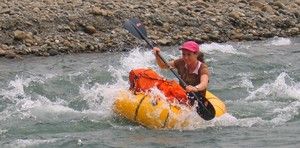 Involuntary bath: On the first
day I do not pay attention with a few rapids so surely and before
I I provide I am driven directly towards a tree top lying in the water.
I make me quite half on an involuntary bath insert calmly, nevertheless,
anyhow I just still rush thus under some of the prickly branches through.
Actually, I have feared that the thorns slit the boat, however, fortunately,
only the watertight stack bag has a small tear as well as me a scratch
in hand and upper arm. This would have gone well over again. Then
on the second day we come to a place in the current to us directly
to a cliff face presses. This time Nadine does not pay attention and
before she itself provides she already inserts an involuntary bath
insert. By the action we lose annoyingly two our drinking water bottles,
but otherwise everybody is (Nadine, boat, and things in the stack
bag) well. Involuntary bath: On the first
day I do not pay attention with a few rapids so surely and before
I I provide I am driven directly towards a tree top lying in the water.
I make me quite half on an involuntary bath insert calmly, nevertheless,
anyhow I just still rush thus under some of the prickly branches through.
Actually, I have feared that the thorns slit the boat, however, fortunately,
only the watertight stack bag has a small tear as well as me a scratch
in hand and upper arm. This would have gone well over again. Then
on the second day we come to a place in the current to us directly
to a cliff face presses. This time Nadine does not pay attention and
before she itself provides she already inserts an involuntary bath
insert. By the action we lose annoyingly two our drinking water bottles,
but otherwise everybody is (Nadine, boat, and things in the stack
bag) well. |
| |
228. Weekly report 08.10. - 14/10/2007
Route: Caranabi, Mayaya, Rurennabaque, Caranavi |
| |
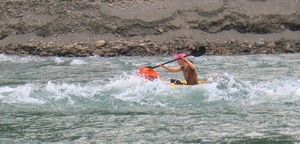 Nadine in action: Nadine in action: |
| |
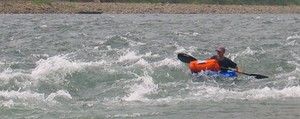 Rio Kaka: After one and a half days we reach Rio Kaka.
Nevertheless, differently than Rio Coroico Rio Kaka is quiet a brown
broth and, moreover, by no means as expected. It goes furthermore
through the mountains and because we will have now more water the
rapids greater and a little more wildly. After the nice clear water
of the first both days it is funny anyhow to paddle in the slushy
brown water and in particular with the rapids it works in such a way,
as if one shook a cup of cocoa hard. On the second day a gigantic
rock lump lies all at once in a narrow place in the middle of the
river. Nevertheless, though with our water level the place is easily
mobile demandingly. However, we find out from the other boaters that
there were many sometimes deadly accidents here in the rainy season.
Then with rising water level recorder the waves and whirlpools become
because bigger, so that even big boats capsize. Rio Kaka: After one and a half days we reach Rio Kaka.
Nevertheless, differently than Rio Coroico Rio Kaka is quiet a brown
broth and, moreover, by no means as expected. It goes furthermore
through the mountains and because we will have now more water the
rapids greater and a little more wildly. After the nice clear water
of the first both days it is funny anyhow to paddle in the slushy
brown water and in particular with the rapids it works in such a way,
as if one shook a cup of cocoa hard. On the second day a gigantic
rock lump lies all at once in a narrow place in the middle of the
river. Nevertheless, though with our water level the place is easily
mobile demandingly. However, we find out from the other boaters that
there were many sometimes deadly accidents here in the rainy season.
Then with rising water level recorder the waves and whirlpools become
because bigger, so that even big boats capsize. |
| |
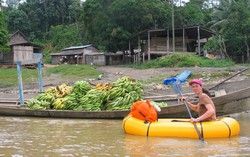 Mayaya: Mayaya is the first bigger
place we in the morning of the 4th day happen. While Nadine in the
upper village our bread and biscuit stocks freshens I talk to the
driver of a banana cutter. Because the place has been at a distance
a little bit, nevertheless, the inhabitants have been surprised a
little bit like us then have come here. Mayaya: Mayaya is the first bigger
place we in the morning of the 4th day happen. While Nadine in the
upper village our bread and biscuit stocks freshens I talk to the
driver of a banana cutter. Because the place has been at a distance
a little bit, nevertheless, the inhabitants have been surprised a
little bit like us then have come here. |
| |
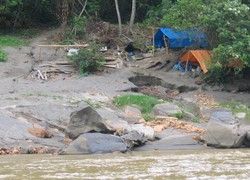 Gold panner: Some years ago gold was found
here in Rio Kaka and everywhere thus we hit on the river on the gold
panners who live here under easy tarpaulins. He would wash 1-2 grammes
of gold on the day with his golden frying pan from the rock, one of
the gold panners believes just on the way back about his family in
Mayaya is. I mean a hard work, however, he means he must work for
it only 6 hours and it would be also so strenuous not, even if it
is quite quite cold constantly in the cold river to stand. It is not
the gesündeste job, moreover, also, because the gold is released here
still with mercury what reduces of course also our paddle fun in the
brown broth. Nevertheless, some gold panners seemed to keep free to
themselves Sunday afternoon, because when we along them paddle many
sit on which rock at all above the river in the middle of the Jungle
(we it is often a riddle like they have come without boat there) and
enjoy the afternoon. Every time if we them happen they wave we would
become ebullient and mine become same of the dangerous rapids come.
The official golden price lies, by the way, at the moment with 18.23
€ per gramme, however, thus a lot the golden seekers will not agree
absolutely! Gold panner: Some years ago gold was found
here in Rio Kaka and everywhere thus we hit on the river on the gold
panners who live here under easy tarpaulins. He would wash 1-2 grammes
of gold on the day with his golden frying pan from the rock, one of
the gold panners believes just on the way back about his family in
Mayaya is. I mean a hard work, however, he means he must work for
it only 6 hours and it would be also so strenuous not, even if it
is quite quite cold constantly in the cold river to stand. It is not
the gesündeste job, moreover, also, because the gold is released here
still with mercury what reduces of course also our paddle fun in the
brown broth. Nevertheless, some gold panners seemed to keep free to
themselves Sunday afternoon, because when we along them paddle many
sit on which rock at all above the river in the middle of the Jungle
(we it is often a riddle like they have come without boat there) and
enjoy the afternoon. Every time if we them happen they wave we would
become ebullient and mine become same of the dangerous rapids come.
The official golden price lies, by the way, at the moment with 18.23
€ per gramme, however, thus a lot the golden seekers will not agree
absolutely! |
| |
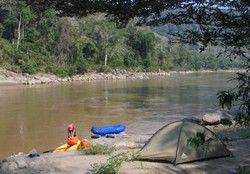 Fantastic tent sites: As always in our
boat tours we have again the good fortune beautiful tents to find.
The mosquitoes keep Fortunately halfway back, while the Sandflies
us sometimes sooner than we would like to force into the tent. After
all those cold nights are the hot humid temperatures below somewhat
unusual for us and so we usually sleep without sleeping bag. While
on the Altiplano wind and road noise are the only sources were here
in the Jungle is an incredible noise. The animals that make noise
probably see more adventurous than the noise they make suggests. In
particular, the cicadas are often so loud that we are finding it hard
to entertain. Fantastic tent sites: As always in our
boat tours we have again the good fortune beautiful tents to find.
The mosquitoes keep Fortunately halfway back, while the Sandflies
us sometimes sooner than we would like to force into the tent. After
all those cold nights are the hot humid temperatures below somewhat
unusual for us and so we usually sleep without sleeping bag. While
on the Altiplano wind and road noise are the only sources were here
in the Jungle is an incredible noise. The animals that make noise
probably see more adventurous than the noise they make suggests. In
particular, the cicadas are often so loud that we are finding it hard
to entertain. |
| |
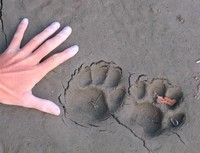 Jaguar tracks: In a camp site we discover
big clear tracks of tapirs and Jaguar. Because it also smells a little
bit strictly we suppose here the district border of one of the nice
big cats. A little bit rottenly Nadine is already to courage when
it is a crash at night constantly according to in the bushes, however,
apparently Jaguar has at the moment no appetite for thin bicycle tourists.
Quite differently than an Armeisenstamm which has eaten, attracted
by an empty chocolate row paper, by our tent ground. We have about
Saying 'du' big holes in the tent ground for I later several hours
will will need to mend around them. Jaguar tracks: In a camp site we discover
big clear tracks of tapirs and Jaguar. Because it also smells a little
bit strictly we suppose here the district border of one of the nice
big cats. A little bit rottenly Nadine is already to courage when
it is a crash at night constantly according to in the bushes, however,
apparently Jaguar has at the moment no appetite for thin bicycle tourists.
Quite differently than an Armeisenstamm which has eaten, attracted
by an empty chocolate row paper, by our tent ground. We have about
Saying 'du' big holes in the tent ground for I later several hours
will will need to mend around them. |
| |
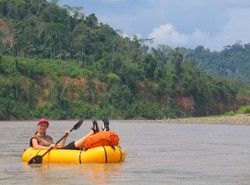 Rio Beni: Finally, we reach to Rio Beni here already
a big wide river is. Even if there hardly rapids is so we have mostly
still good current, so that we often can be laid just decayed in our
boats and done ourselves. Rio Beni: Finally, we reach to Rio Beni here already
a big wide river is. Even if there hardly rapids is so we have mostly
still good current, so that we often can be laid just decayed in our
boats and done ourselves. |
| |
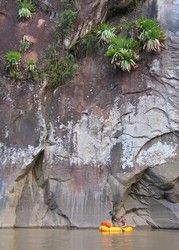 Great canyons: Rio Beni crosses another
two mountain ranges in those the high precipitous cliff faces often
to directly to the river approach. Here, actually, there should be
Anacondas, Jaguars, tapirs and Capybaras, however, up to two Capybaras
before us fast in the Jungle flee we get nothing to see. There are
merely parrots, water birds and gigantic butterflies richly. Great canyons: Rio Beni crosses another
two mountain ranges in those the high precipitous cliff faces often
to directly to the river approach. Here, actually, there should be
Anacondas, Jaguars, tapirs and Capybaras, however, up to two Capybaras
before us fast in the Jungle flee we get nothing to see. There are
merely parrots, water birds and gigantic butterflies richly. |
| |
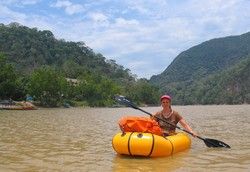 Rurrenabaque: Finally, after 6 days we
reach about midday the Junglestädtchen Rurrenabaque earlier than expected.
We feel fine in the small small town surely and the comfortably activity
and many moped riders remind us strongly of the Luang Prabang situated
in the Mekong in Laos. Many tourists come to explore to Rurrenabaque
around the surrounding primeval forests and grass sceneries on controlled
tours. Nevertheless, controlled tours are not completely thus our
thing (even if one gets compulsory here a lot for his money, nevertheless,
one can observe on the pampas tours, among the rest, Anacondas and
freshwater dolphins) and thus we rather wander by the fruit market
and vegetable market and talk a little bit with the juice shop assistants. Rurrenabaque: Finally, after 6 days we
reach about midday the Junglestädtchen Rurrenabaque earlier than expected.
We feel fine in the small small town surely and the comfortably activity
and many moped riders remind us strongly of the Luang Prabang situated
in the Mekong in Laos. Many tourists come to explore to Rurrenabaque
around the surrounding primeval forests and grass sceneries on controlled
tours. Nevertheless, controlled tours are not completely thus our
thing (even if one gets compulsory here a lot for his money, nevertheless,
one can observe on the pampas tours, among the rest, Anacondas and
freshwater dolphins) and thus we rather wander by the fruit market
and vegetable market and talk a little bit with the juice shop assistants. |
| |
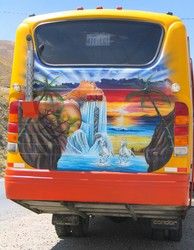 Nice coach journey: Back we go to Caranavi
then by the coach. Although the coach journey should last only about
270 km away 10 hours. Immediately in the end of the town the coach
already stops and both substitute drivers jump out around something
in a store to look. Finally, the driver also gets out and when he
just 15 m of the coach is away this starts to stutter in and simply
goes out. The fright stands in a queue to our coach team on the face
written and the substitute driver reprimands immediately his colleague
for which reason he has got out generally. The thing is clear: the
starter of the coach is broken, and thus we rise from by him again
to bowl first. During the next hour we urge another 3x in order food
for a passenger to buy 5 water melons for the coach drivers and oil
for our coach. Then the oil is also refilled immediately during the
journey, because the Öleinfüllstutzen is to be reached by a hatch
in the way. After 3 hours we reach Yucumo where a half-hour lunchbreak
is included in the plan. While we just what eat the coach on the way
comes along in a work town. After the lunchbreak then the info that
there are problems with the steering hydraulics and we would go on
only in one hour. We make it to ourselves on the seats in the taxi
stand comfortable and observe the activity of the small place. Nevertheless,
one seems to be rather run-decayed here, because instead of running
30 m to the motorcycle taxi stand the potential customers stand on
the door thresholds of the respective stores and shout rather for
several minutes to them of one of the Mopedjungs are fetched. Then
the distances are not also so far and it can feel well that one gives
up himself only 100 m farther to another store. After the hour has
passed by it should go on at 10 minutes. 10 minutes stretch and at
last we go on after a 3-hour break. Because our coach team constantly
in screw was and no time had to eat what we give them our remaining
bananas, after one of the boys had asked us for a banana which they
accept though hesitantly, however, still thankfully. With nothing
but joy that the coach again runs we also open immediately again and
only when a few women start to shout "Faltan pasajeros!" strikes that
another two passengers are absent. They have noted too late the departure
of the coach and now are postdriven by 2 Mopedjungs. One rules playfully
and happily mood and none of the passengers looks irritated or irritated
because of de delay. When the women find out that our coach drivers
have got no lunch they make a pilgrimage one after other forwards
around our heroes with delicacies to supply. The friendly helpful
kind of the Bolivianos impresses us strongly. Now our coach driver
tries to catch up the lost time again and races we mad about the narrow
dust runways. Everything what on the street is he expels with his
loud horn and we are glad that we do not meet him on our bicycles.
Although we a few more urge sometimes to examine the steering system,
finally, we reach after 14 hours of Caranabi. The coach adventure
offered, by the way, for just 3.50 € a top price achievement relation:-)) Nice coach journey: Back we go to Caranavi
then by the coach. Although the coach journey should last only about
270 km away 10 hours. Immediately in the end of the town the coach
already stops and both substitute drivers jump out around something
in a store to look. Finally, the driver also gets out and when he
just 15 m of the coach is away this starts to stutter in and simply
goes out. The fright stands in a queue to our coach team on the face
written and the substitute driver reprimands immediately his colleague
for which reason he has got out generally. The thing is clear: the
starter of the coach is broken, and thus we rise from by him again
to bowl first. During the next hour we urge another 3x in order food
for a passenger to buy 5 water melons for the coach drivers and oil
for our coach. Then the oil is also refilled immediately during the
journey, because the Öleinfüllstutzen is to be reached by a hatch
in the way. After 3 hours we reach Yucumo where a half-hour lunchbreak
is included in the plan. While we just what eat the coach on the way
comes along in a work town. After the lunchbreak then the info that
there are problems with the steering hydraulics and we would go on
only in one hour. We make it to ourselves on the seats in the taxi
stand comfortable and observe the activity of the small place. Nevertheless,
one seems to be rather run-decayed here, because instead of running
30 m to the motorcycle taxi stand the potential customers stand on
the door thresholds of the respective stores and shout rather for
several minutes to them of one of the Mopedjungs are fetched. Then
the distances are not also so far and it can feel well that one gives
up himself only 100 m farther to another store. After the hour has
passed by it should go on at 10 minutes. 10 minutes stretch and at
last we go on after a 3-hour break. Because our coach team constantly
in screw was and no time had to eat what we give them our remaining
bananas, after one of the boys had asked us for a banana which they
accept though hesitantly, however, still thankfully. With nothing
but joy that the coach again runs we also open immediately again and
only when a few women start to shout "Faltan pasajeros!" strikes that
another two passengers are absent. They have noted too late the departure
of the coach and now are postdriven by 2 Mopedjungs. One rules playfully
and happily mood and none of the passengers looks irritated or irritated
because of de delay. When the women find out that our coach drivers
have got no lunch they make a pilgrimage one after other forwards
around our heroes with delicacies to supply. The friendly helpful
kind of the Bolivianos impresses us strongly. Now our coach driver
tries to catch up the lost time again and races we mad about the narrow
dust runways. Everything what on the street is he expels with his
loud horn and we are glad that we do not meet him on our bicycles.
Although we a few more urge sometimes to examine the steering system,
finally, we reach after 14 hours of Caranabi. The coach adventure
offered, by the way, for just 3.50 € a top price achievement relation:-)) |
| |
229. Weekly report 15.10. - 21/10/2007
Route: La Paz |
| |
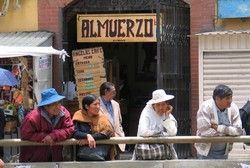 Waiting for Christmas: After we have succeeded
meanwhile VAUDE to win as a right equipment sponsor now we can exchange
some of our very worn clothing pieces for new ones. To have to pay
have no import tax we allow to send the package to the German message
and there the German post a delivery within 4-6 days accepts here
we decide to wait in La Paz. However, the German post is not apparent
also any more what it was sometimes, because after 8 days the package
is not yet here. We wait patiently further and spend our time with
it our Spanish books to work through. Waiting for Christmas: After we have succeeded
meanwhile VAUDE to win as a right equipment sponsor now we can exchange
some of our very worn clothing pieces for new ones. To have to pay
have no import tax we allow to send the package to the German message
and there the German post a delivery within 4-6 days accepts here
we decide to wait in La Paz. However, the German post is not apparent
also any more what it was sometimes, because after 8 days the package
is not yet here. We wait patiently further and spend our time with
it our Spanish books to work through. |
| |
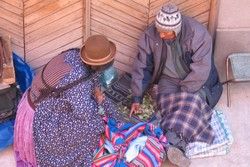 Foreteller: In the street before our Hostel always
sit several foretellers who forecast her predominantly female customers
the future on the basis of Coke sheets which they throw on the ground. Foreteller: In the street before our Hostel always
sit several foretellers who forecast her predominantly female customers
the future on the basis of Coke sheets which they throw on the ground. |
| |
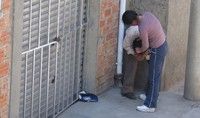 Strong women: The women in Bolivia are
very strong, and with it I think not only her social role how this
young woman proves which clobbers just her partner, because he came
the last night not home. Strong women: The women in Bolivia are
very strong, and with it I think not only her social role how this
young woman proves which clobbers just her partner, because he came
the last night not home. |
| |
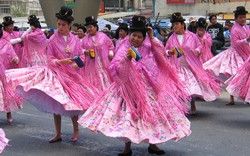 Parade: On Sunday morning we hear march music and
gun salutes once again and curiously we proceed to the Plaza San Franzisko
where we hit on a festival move continuing several hours. Nevertheless,
though the move is not ours first in Bolivia we are fascinated on
new by many great costumes. Parade: On Sunday morning we hear march music and
gun salutes once again and curiously we proceed to the Plaza San Franzisko
where we hit on a festival move continuing several hours. Nevertheless,
though the move is not ours first in Bolivia we are fascinated on
new by many great costumes. |
| |
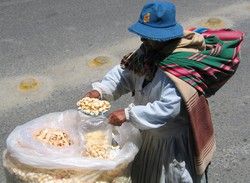 Snacks: In gigantic bags the
women sell here a sort of pop grain. While some women the bags in
a barrow by the area drive her baby on during them the back must carry
this older woman the bag, nevertheless drag. Snacks: In gigantic bags the
women sell here a sort of pop grain. While some women the bags in
a barrow by the area drive her baby on during them the back must carry
this older woman the bag, nevertheless drag. |
| |
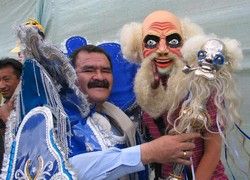 Who I am: Actually, I want to take only one photo
of the mask, however, the dancer insists on the fact that Nadine them
touched down has to go. I like Nadine without, nevertheless, better! Who I am: Actually, I want to take only one photo
of the mask, however, the dancer insists on the fact that Nadine them
touched down has to go. I like Nadine without, nevertheless, better! |
| |
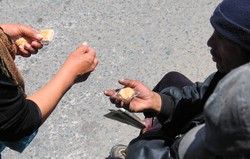 Indian: Beside the Bolivians
also take part in each case a group of the Chinese and Indian immigrants
in the move. While the Chinese with a gigantic long dragon through
the street run the Indians Süssgebäck distribute to the spectators. Indian: Beside the Bolivians
also take part in each case a group of the Chinese and Indian immigrants
in the move. While the Chinese with a gigantic long dragon through
the street run the Indians Süssgebäck distribute to the spectators. |
| |
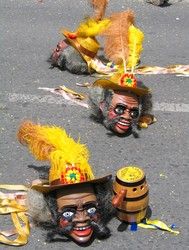 Masks: Today it is so warm and
sunny that herself a woman the chill beer in the shoes pours around
her swollen feet to cool, and we get a sunburn. The dancers must sweat
under her masks quite substantially, and thus it is no miracle that
they set down them in every break. Masks: Today it is so warm and
sunny that herself a woman the chill beer in the shoes pours around
her swollen feet to cool, and we get a sunburn. The dancers must sweat
under her masks quite substantially, and thus it is no miracle that
they set down them in every break. |
| |
|
230. Weekly report 22.10. - 28/10/2007
Route: La Paz
|
| |
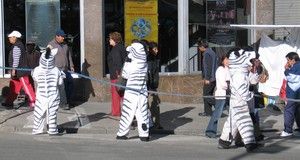 Attention zebras!!! As a pedestrian one
crosses in Bolivia the street whenever one wants. As long as one observes,
besides, the traffic and always nicely well to the cars, coach and
Lkws makes way passed also nothing, however, one Must already pay
attention. If a policeman on the street is once around the traffic
to regulate his instructions are valid of course only for the drivers.
The pedestrians make furthermore what they want. To gain control of
the pedestrians in the Plaza San Francisco here there is quite a special
"zebra crossing". Here as a zebra dressed up youngsters the pedestrians
try to educate to a little bit more discipline. However, without thick
ropes with those them in each case the roadway block off if they had
no chance! Attention zebras!!! As a pedestrian one
crosses in Bolivia the street whenever one wants. As long as one observes,
besides, the traffic and always nicely well to the cars, coach and
Lkws makes way passed also nothing, however, one Must already pay
attention. If a policeman on the street is once around the traffic
to regulate his instructions are valid of course only for the drivers.
The pedestrians make furthermore what they want. To gain control of
the pedestrians in the Plaza San Francisco here there is quite a special
"zebra crossing". Here as a zebra dressed up youngsters the pedestrians
try to educate to a little bit more discipline. However, without thick
ropes with those them in each case the roadway block off if they had
no chance! |
| |
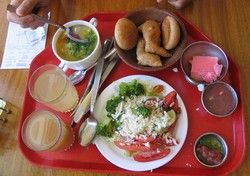 Lunch menu: For converted just 1.80 € one
gets in Gloria hotel in La Paz a vegetarian midday menu from allerfeinsten.
Beside salad plate, bread, soup, main food, dessert and tea there
are still two cold drinks. The menu is so extensive that we always
divide one because it would be for one for us too much (the main way
is not on the photo!). Very much we have surprised that the restaurant
is full of craze every time, and many of the guests older (60 +) lawyers
(the court of law is next door) and businessmen in suits are. Lunch menu: For converted just 1.80 € one
gets in Gloria hotel in La Paz a vegetarian midday menu from allerfeinsten.
Beside salad plate, bread, soup, main food, dessert and tea there
are still two cold drinks. The menu is so extensive that we always
divide one because it would be for one for us too much (the main way
is not on the photo!). Very much we have surprised that the restaurant
is full of craze every time, and many of the guests older (60 +) lawyers
(the court of law is next door) and businessmen in suits are. |
| |
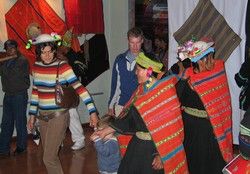 Visit to the cinema: Although yet two years in the
office there is not about the life and the development of the bolivianischen
president already a film. We have gone to the premiere to cinema and
because there should be dance presentations we have rather been there
a little bit. Then there were of course dance presentations, however
before we we provided we became from the viewer the dancer. I believe
we have danced together absolutely during 20 minutes! The film itself
was very interesting, nevertheless, he showed not only the way of
an impoverished farm boy from the Altiplano first to indigenen presidents
of South America, but also many insights into the life everyday life
of the normal Bolivians. With Evo Morales Bolivia has a president
him his country, his people and his problem from own experience of
life knows. We hope that he cheers all moved is able. Visit to the cinema: Although yet two years in the
office there is not about the life and the development of the bolivianischen
president already a film. We have gone to the premiere to cinema and
because there should be dance presentations we have rather been there
a little bit. Then there were of course dance presentations, however
before we we provided we became from the viewer the dancer. I believe
we have danced together absolutely during 20 minutes! The film itself
was very interesting, nevertheless, he showed not only the way of
an impoverished farm boy from the Altiplano first to indigenen presidents
of South America, but also many insights into the life everyday life
of the normal Bolivians. With Evo Morales Bolivia has a president
him his country, his people and his problem from own experience of
life knows. We hope that he cheers all moved is able. |
| |
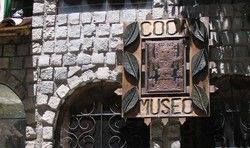 The Coca sheet and his history: In
La Paz there is a small however fine Coca museum. In the museum all
texts are translated completely also in German what receives with
the extensive information one is very pleasant here. The oldest
remains of Coca sheets became in coffins in the ruins of Huanca Prieto
in Nordperu (in 2500 - in 1800 B.C.) found. Further there are tips
that already in 2100 v Chr. have chewed the Valdiviana Coca . In 1200
- in 147 A.D. the Incas extracted the Cocaoil around with his help
cerebral operations to carry out. In 1551 A.D. the Catholic church
calls the Coca sheet "diabolical" and arranges the destruction. At
that time the monthly consumption of Cokablättern in the silver mines
of Potosi had put out an equivalent of 450 km of gold. Coca raises
the suffering readiness of the mine workers and to be able to exploit
this more the Coca ban of the church was lifted under pressure by
Felipe II again. Now, however, the church raises 10% of tax on Coke!
Coke was now and again even so valuably in Potosi that the Coca sheets
were valid as a currency. In 1609 A.D. doctors use to cure the Coca
sheet around wounds. In 1860 Albert Niemann (Goettingen) discovered
the anästhetische effect from Coke. It develops a legal Cocainboom
and the Coca wine Mariuaru storms the markets of Paris. In 1884 Simund
Freud publishes, the first cocaine consumer of the history, an article
about cocaine (Freud dies later of nasal cancer presumably on account
of the Cocaconsums). In 1886 there comes a soft drink on Coca base
on the market: Coca Cola! In 1905 there comes Pracain, synthetic cocaine,
on the market and edges out the natural one. In 1914 cocaine is forbidden.
In 1950 the United Nations fire at the destruction of Coca . Because
it is produced "mental disturbances and is responsible for the poverty
in South America". In 1961 Bolivia signs a contract also the masticating
of Coke forbids (meanwhile, however, again lifted). In 1976 Harvard
university is published in a study, that the Coke sheet (if it is
chewed!) from food-scientific view with millet, maize and wheat is
comparable. In 1978 a study will chew she publishes aforesaid, that
in the rural areas of Bolivia 92% of the men and 89% of the Mrs. Cocablätter.
From 1983 industrial cultivation of Coca in Bolivia for alternative
products (Liqueur, bobsleigh vouchers, toothpaste, drugs). The Coca sheet and his history: In
La Paz there is a small however fine Coca museum. In the museum all
texts are translated completely also in German what receives with
the extensive information one is very pleasant here. The oldest
remains of Coca sheets became in coffins in the ruins of Huanca Prieto
in Nordperu (in 2500 - in 1800 B.C.) found. Further there are tips
that already in 2100 v Chr. have chewed the Valdiviana Coca . In 1200
- in 147 A.D. the Incas extracted the Cocaoil around with his help
cerebral operations to carry out. In 1551 A.D. the Catholic church
calls the Coca sheet "diabolical" and arranges the destruction. At
that time the monthly consumption of Cokablättern in the silver mines
of Potosi had put out an equivalent of 450 km of gold. Coca raises
the suffering readiness of the mine workers and to be able to exploit
this more the Coca ban of the church was lifted under pressure by
Felipe II again. Now, however, the church raises 10% of tax on Coke!
Coke was now and again even so valuably in Potosi that the Coca sheets
were valid as a currency. In 1609 A.D. doctors use to cure the Coca
sheet around wounds. In 1860 Albert Niemann (Goettingen) discovered
the anästhetische effect from Coke. It develops a legal Cocainboom
and the Coca wine Mariuaru storms the markets of Paris. In 1884 Simund
Freud publishes, the first cocaine consumer of the history, an article
about cocaine (Freud dies later of nasal cancer presumably on account
of the Cocaconsums). In 1886 there comes a soft drink on Coca base
on the market: Coca Cola! In 1905 there comes Pracain, synthetic cocaine,
on the market and edges out the natural one. In 1914 cocaine is forbidden.
In 1950 the United Nations fire at the destruction of Coca . Because
it is produced "mental disturbances and is responsible for the poverty
in South America". In 1961 Bolivia signs a contract also the masticating
of Coke forbids (meanwhile, however, again lifted). In 1976 Harvard
university is published in a study, that the Coke sheet (if it is
chewed!) from food-scientific view with millet, maize and wheat is
comparable. In 1978 a study will chew she publishes aforesaid, that
in the rural areas of Bolivia 92% of the men and 89% of the Mrs. Cocablätter.
From 1983 industrial cultivation of Coca in Bolivia for alternative
products (Liqueur, bobsleigh vouchers, toothpaste, drugs). |
| |
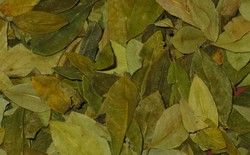 "Acullico": The traditional way of the Coca consumption
is the Acuillo, the masticating of the Coca sheet. The technology
was developed about 4000 years ago and enables with the help of "Llycta"
of an alkaline substance (Carbonat from the cinder of banana plants
or millet) to extract the nutrients and alkaloids of the Coca sheet.
Besides, the sheets are crushed only between the teeth and afterwards
are pushed in a cheek. Then after 10-15 minutes if the sheets are
soft the Llycta is taken and the sheets are sucked out. With this
technology can be used up to 90% of the Nähstoffe of the sheet. The
Acuillo is carried out 2-3x daily (mostly after the meals) and is
a social event comparably with the coffee drink with us. "Acullico": The traditional way of the Coca consumption
is the Acuillo, the masticating of the Coca sheet. The technology
was developed about 4000 years ago and enables with the help of "Llycta"
of an alkaline substance (Carbonat from the cinder of banana plants
or millet) to extract the nutrients and alkaloids of the Coca sheet.
Besides, the sheets are crushed only between the teeth and afterwards
are pushed in a cheek. Then after 10-15 minutes if the sheets are
soft the Llycta is taken and the sheets are sucked out. With this
technology can be used up to 90% of the Nähstoffe of the sheet. The
Acuillo is carried out 2-3x daily (mostly after the meals) and is
a social event comparably with the coffee drink with us. |
| |
| The effect of Coca: The effect
of Coca according to a scientific study of the Instituto Boliviano
de Biologica de la Altura: Coca contains three alkaloids, cocaine
and two chemical variations. The Acuillo increases the tolerance concerning
work, stimulates the respiration (improvement of Sauerstoffaufnahem
and combustion), decreases the luiquid of the blood cells (therefore
reduced thrombosis danger), adjusts the glucose metabolism (insulin
circulation, sugar metabolism) and stabilises the sugar household,
contributes substantially to the height adaptation and does not affect,
besides, the normal absorption of nutrients. |
| |
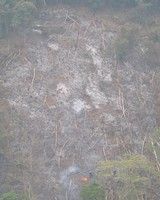 Coca farming: The traditional Coca cultivation of
the soft and more sweetish sheets occurs in the precipitous slopes
of the Yungas during the unlawful drug cultivation in the region of
Chapare is to be found. The small Coca fields in the Yungas are managed
by families or the village community and there 3-4x per year a harvest
possibly is the Coke cultivation shows here often the only form of
a regulated income. While the men will prepare the fields the harvest
traditionally from the women explained (social privilege) who draw
for it her best clothes. On our way to Caranabi we have seen the small
fields and the fire clearings necessary for new fields over and over
again. Coca farming: The traditional Coca cultivation of
the soft and more sweetish sheets occurs in the precipitous slopes
of the Yungas during the unlawful drug cultivation in the region of
Chapare is to be found. The small Coca fields in the Yungas are managed
by families or the village community and there 3-4x per year a harvest
possibly is the Coke cultivation shows here often the only form of
a regulated income. While the men will prepare the fields the harvest
traditionally from the women explained (social privilege) who draw
for it her best clothes. On our way to Caranabi we have seen the small
fields and the fire clearings necessary for new fields over and over
again. |
| |
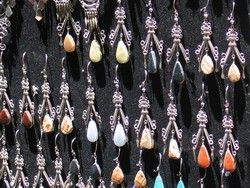 Production costs for cocaine:
To produce 1 kg of cocaine resulted in 1997 the following costs: Coca
paste: Worker (for the Cocatreter about 5$US per hour earn) 350$US,
Coca sheets (323 kg) in 1615$US, other (acids, lime oxide...) 200,
- $US. All together in 2185$US. Then in laboratories it is crystallised
1 kg of Coca paste to 1 kg of cocaine chlorine hydrate. Although this
is made in impromptu unlawful laboratories the crystallisation process
is complicated and requires an extensive chemical knowledge. Cocaine:
Coca paste in 2185$US, unlawful chemicals in 1000$US. A total of in
3185$US and the labour cost of the "certified manpower" was
not considered in the laboratories there in addition no data gives.
The topical market value for 1 kg of cocaine lies according to Internet
with 35,000, - € and this is stretched then already several times
with glucose and other knickknack and is only 40%)! Production costs for cocaine:
To produce 1 kg of cocaine resulted in 1997 the following costs: Coca
paste: Worker (for the Cocatreter about 5$US per hour earn) 350$US,
Coca sheets (323 kg) in 1615$US, other (acids, lime oxide...) 200,
- $US. All together in 2185$US. Then in laboratories it is crystallised
1 kg of Coca paste to 1 kg of cocaine chlorine hydrate. Although this
is made in impromptu unlawful laboratories the crystallisation process
is complicated and requires an extensive chemical knowledge. Cocaine:
Coca paste in 2185$US, unlawful chemicals in 1000$US. A total of in
3185$US and the labour cost of the "certified manpower" was
not considered in the laboratories there in addition no data gives.
The topical market value for 1 kg of cocaine lies according to Internet
with 35,000, - € and this is stretched then already several times
with glucose and other knickknack and is only 40%)! |
| |
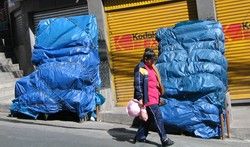 Market stalls: Every evening the Bolivianischen
market woman pack her market stalls with the product in plastic foil
one. We are impressed, because this are meant that theft is in principle
no problem! Market stalls: Every evening the Bolivianischen
market woman pack her market stalls with the product in plastic foil
one. We are impressed, because this are meant that theft is in principle
no problem! |
| |
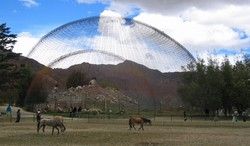 Zoo visit: On Sunday afternoon we make an excursion
to the south of La Paz. On the coach journey down by the amusing canyon
Nadine goes off in such a way that she must vomit from the coach window.
To the Rehabilisierung it goes first of all in a nice park before
we transfer us in the zoo. Especially well we have liked the condor's
enclosure in the zoo which is a gigantic Gitterkubbel, so that the
immense birds even the possibility have to fly a little bit. Zoo visit: On Sunday afternoon we make an excursion
to the south of La Paz. On the coach journey down by the amusing canyon
Nadine goes off in such a way that she must vomit from the coach window.
To the Rehabilisierung it goes first of all in a nice park before
we transfer us in the zoo. Especially well we have liked the condor's
enclosure in the zoo which is a gigantic Gitterkubbel, so that the
immense birds even the possibility have to fly a little bit. |
| |
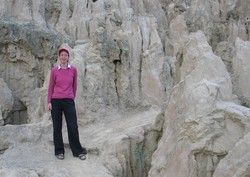 Valle de la Luna: Here near the zoo the Valle de la
Luna (lunar valley) and in comparison to the other "lunar valleys"
we also lies in South America have seen here she winds a narrow and
path adventurous now and again between the mucky pileworks through. Valle de la Luna: Here near the zoo the Valle de la
Luna (lunar valley) and in comparison to the other "lunar valleys"
we also lies in South America have seen here she winds a narrow and
path adventurous now and again between the mucky pileworks through. |
| |
231. Weekly report 29.10. - 04/11/2007
Route: La Paz, San Pedro, Copacabana, Isla de Sol |
| |
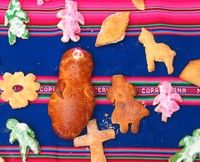 All Saints' Day: Here for All Saints' Day
there is in Bolivia the special cake which there is in the Plaza San
Franzisko already in the whole week before the holiday in especially
for it to built up market stalls. Beside cake in cross form there
are green little men and mauve women, as well as a little bigger figures
with a painted face from gypsum. Nevertheless, unfortunately, the
biscuits do not taste completely soooo well like they look. All Saints' Day: Here for All Saints' Day
there is in Bolivia the special cake which there is in the Plaza San
Franzisko already in the whole week before the holiday in especially
for it to built up market stalls. Beside cake in cross form there
are green little men and mauve women, as well as a little bigger figures
with a painted face from gypsum. Nevertheless, unfortunately, the
biscuits do not taste completely soooo well like they look. |
| |
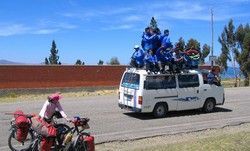 All Souls' Day: More importantly still than All Saints'
Day seems to be the holiday All Souls' Day in Bolivia on the 02nd
of November. All Bolivians and Bolivianerinnen we see are dressed
up superchick. One meets, goes on the cemetery, sits in the street
and observes the traffic, has a barbecue or plays together music.
We see every few metres in the street edge a group of flutists standing
which play traditional bolivianische songs accompanied from a drummer.
Some music groups have organised even a small coach. The whole troop
sits making music on top on the roof, while the coach drives up and
sets off in the village. All Souls' Day: More importantly still than All Saints'
Day seems to be the holiday All Souls' Day in Bolivia on the 02nd
of November. All Bolivians and Bolivianerinnen we see are dressed
up superchick. One meets, goes on the cemetery, sits in the street
and observes the traffic, has a barbecue or plays together music.
We see every few metres in the street edge a group of flutists standing
which play traditional bolivianische songs accompanied from a drummer.
Some music groups have organised even a small coach. The whole troop
sits making music on top on the roof, while the coach drives up and
sets off in the village. |
| |
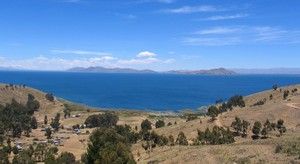 Titikakasee: The Titikakasee is höchstgelegene from
big ships a practicable sea of the world and lies between Bolivia
and Peru. However, Bolivia, since the war with Chile of his sea access
(and his rich mines) sticks robbed furthermore stubbornly to his navy
which has lain now with the Titikakasee. The water of the lake is
still delightfully clear, however because more and more sewage is
escorted in the lake it is fine only one matter of time to itself
this changes. Titikakasee: The Titikakasee is höchstgelegene from
big ships a practicable sea of the world and lies between Bolivia
and Peru. However, Bolivia, since the war with Chile of his sea access
(and his rich mines) sticks robbed furthermore stubbornly to his navy
which has lain now with the Titikakasee. The water of the lake is
still delightfully clear, however because more and more sewage is
escorted in the lake it is fine only one matter of time to itself
this changes. |
| |
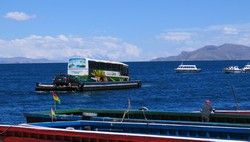 Boat crossing: To come after the Cocacabana
situated on a peninsula we have to go with Taquila about the Titikakasee
translated. Together by two cars we will load by our bicycles onto
one of the level wooden rowing boats and sail so slowly and comfortably
over the lake. When the wind refreshes something and the waves become
a little big, nevertheless, the whole one swings rather substantially,
however, luckily we are not with one of the really questionably swaying
penalties on the rowing boat. The invitation and unloading is typical
bolivianisch and accordingly chaotically organised. Thus there is
a landing stage for bringing up on the rowing boat and a landing stage
for driving down. This means that a loaded rowing boat only puts in.
If the rowing boat has put in the ticket is cashed up by the driver
and this drives down from the rowing boat. . Because, nevertheless,
the waiting vehicles at another place drive up now the rowing boat
puts away again (this time, nevertheless, without engine they separate
it is pushed with wooden poles) to go to the Auffahrstelle where she
puts in once more before the already waiting vehicles may drive up.
No miracle that the empty and full rowing boats always collect before
the respective landing stages. We have waited almost so long before
the landing stage for a burstting like the whole crossing has lasted. Boat crossing: To come after the Cocacabana
situated on a peninsula we have to go with Taquila about the Titikakasee
translated. Together by two cars we will load by our bicycles onto
one of the level wooden rowing boats and sail so slowly and comfortably
over the lake. When the wind refreshes something and the waves become
a little big, nevertheless, the whole one swings rather substantially,
however, luckily we are not with one of the really questionably swaying
penalties on the rowing boat. The invitation and unloading is typical
bolivianisch and accordingly chaotically organised. Thus there is
a landing stage for bringing up on the rowing boat and a landing stage
for driving down. This means that a loaded rowing boat only puts in.
If the rowing boat has put in the ticket is cashed up by the driver
and this drives down from the rowing boat. . Because, nevertheless,
the waiting vehicles at another place drive up now the rowing boat
puts away again (this time, nevertheless, without engine they separate
it is pushed with wooden poles) to go to the Auffahrstelle where she
puts in once more before the already waiting vehicles may drive up.
No miracle that the empty and full rowing boats always collect before
the respective landing stages. We have waited almost so long before
the landing stage for a burstting like the whole crossing has lasted.
|
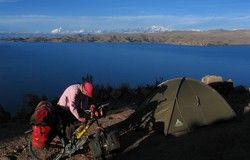 Broken spoke: On the peninsula concerned
we have to go only once over the mountains around to Copacabana to
come. We struggle just laboriously uphill when with Nadines wheel
breaks once again a spoke (third since Salta) and we first of all
quite a while need to exchange around this. All three spoke breaks
were at the quite precisely same place, so that we suppose that the
mechanic has in Salta badly eingespeicht. Now I try to get for the
first time in my life from a rim of wheel the imbalance out and thus
I am occupied first of all quite a while. To Copacabana we would not
create it after the breakdown anyhow any more, and thus we are glad
when we find only few kilometres later a marvellous camp site with
dreamlike view. Broken spoke: On the peninsula concerned
we have to go only once over the mountains around to Copacabana to
come. We struggle just laboriously uphill when with Nadines wheel
breaks once again a spoke (third since Salta) and we first of all
quite a while need to exchange around this. All three spoke breaks
were at the quite precisely same place, so that we suppose that the
mechanic has in Salta badly eingespeicht. Now I try to get for the
first time in my life from a rim of wheel the imbalance out and thus
I am occupied first of all quite a while. To Copacabana we would not
create it after the breakdown anyhow any more, and thus we are glad
when we find only few kilometres later a marvellous camp site with
dreamlike view. |
| |
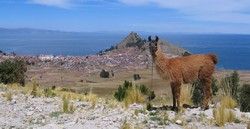 Copacabana: Copacabana is the biggest Bolivianische
place in the Titikakasee and delightfully lies in a small bay. The
small town is removed just 150 km from La Paz and to reach by the
coach in 3.5 hours, so that many Bolivians come making here the vacation.
Copacabana is prepared on the visitor's stream thanks to a lot of
Hostels, restaurants and pedal boat swans, nevertheless, very well.
Apart from the fact the border briefly lies behind Copacabana to Peru,
so that, actually, all tourists from the Machu Pichu from the south
drive here a short interstop insert, nevertheless, one can go from
here on Isla de Sol. When we come is just the extended week-end with
both holidays, so that here the prevailing number of the tourists
Bolivians are, and a lively activity on the street and on the beach
rules. Copacabana: Copacabana is the biggest Bolivianische
place in the Titikakasee and delightfully lies in a small bay. The
small town is removed just 150 km from La Paz and to reach by the
coach in 3.5 hours, so that many Bolivians come making here the vacation.
Copacabana is prepared on the visitor's stream thanks to a lot of
Hostels, restaurants and pedal boat swans, nevertheless, very well.
Apart from the fact the border briefly lies behind Copacabana to Peru,
so that, actually, all tourists from the Machu Pichu from the south
drive here a short interstop insert, nevertheless, one can go from
here on Isla de Sol. When we come is just the extended week-end with
both holidays, so that here the prevailing number of the tourists
Bolivians are, and a lively activity on the street and on the beach
rules.
|
232. Weekly report 05.10. - 11/11/2007
Route: Isla de Sol, Soraata, La Paz, Copacabana |
| |
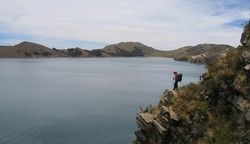 Isla de Sol: 1.5 hours by boat of Copacabana there
lies Isla del Sol. According to the legend originated God with his
both children Manco Kapac and mummy Ocllo the Inca Dynastie has founded
here Viracocha, the creator. The island should be very nicely to the
walking, so that we plan 3 days to spend there. After a quiet comfortable
boat trip we come with many other tourists in the late morning on
Isla de Sol. From Yumani we come along first of all on around the
south part of the island to explore, however, anyhow our map is not
quite correct and thus we struggle by wild Steilhänge. Finally, it
will climb to us too wildly and thus we directly uphill on from the
north after the south running ridges. We find at the southern end
of the ridge a marvellous vantage point in we resting first of all.
We have joined just our lunch consumed as himself one of the islanders
to ourselves. We talk very nicely and find out with the fact that
one solves all juridical matters on Isla de Sol. His job would be
to be seen it in the south part of the island after the right one
and thus he would be just on a controlling way. We ask what it then
here largely would give to control and find out in such a way that
not only the donkeys are to be expelled by the potato fields, but
that there would be increasingly also problems with drugs here. Although
it had rained during the winter months unusually a lot in Bolivia
something has come from many rain hardly on the island which is why
for the next Tuesday a rain ceremony is attached. Because the ceremony
is something holy, the Peruvian Sovenierverkäufer on the island are
not allowed on this day, however, tourists are welcome, nevertheless. Isla de Sol: 1.5 hours by boat of Copacabana there
lies Isla del Sol. According to the legend originated God with his
both children Manco Kapac and mummy Ocllo the Inca Dynastie has founded
here Viracocha, the creator. The island should be very nicely to the
walking, so that we plan 3 days to spend there. After a quiet comfortable
boat trip we come with many other tourists in the late morning on
Isla de Sol. From Yumani we come along first of all on around the
south part of the island to explore, however, anyhow our map is not
quite correct and thus we struggle by wild Steilhänge. Finally, it
will climb to us too wildly and thus we directly uphill on from the
north after the south running ridges. We find at the southern end
of the ridge a marvellous vantage point in we resting first of all.
We have joined just our lunch consumed as himself one of the islanders
to ourselves. We talk very nicely and find out with the fact that
one solves all juridical matters on Isla de Sol. His job would be
to be seen it in the south part of the island after the right one
and thus he would be just on a controlling way. We ask what it then
here largely would give to control and find out in such a way that
not only the donkeys are to be expelled by the potato fields, but
that there would be increasingly also problems with drugs here. Although
it had rained during the winter months unusually a lot in Bolivia
something has come from many rain hardly on the island which is why
for the next Tuesday a rain ceremony is attached. Because the ceremony
is something holy, the Peruvian Sovenierverkäufer on the island are
not allowed on this day, however, tourists are welcome, nevertheless. |
| |
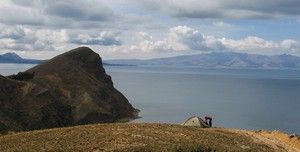 Camping: In the west of Isla
de Sol there is a lonesome ridge we to us to the tent select. Interressanterweise
is the scenery with the suddenly red rock and many cacti absolutely
differently than on the rest of the island. The only hook in the camp
site: I must descend from the burr to down to the lake to come in
water. I run down myself to the descent on the very precipitous west
side and do not look when I meet below on the beach all at once two
Americans who have sat down here in a cave for a few days. However,
still more taken aback the both have looked then her place lay really
very much hidden and is only difficult because of the precipitous
slopes to reach. Then the both are also so friendly and offer her
water filter to me what I accept with pleasure (the first filtered
water in 4.5 years!) because the Titikakasee is not completely so
clean, unfortunately, any more. After my water bag is full I climb
again the mountain slope high to Nadine me quite longingly expects
(she is hungry and, finally, wants to cook dinner). Camping: In the west of Isla
de Sol there is a lonesome ridge we to us to the tent select. Interressanterweise
is the scenery with the suddenly red rock and many cacti absolutely
differently than on the rest of the island. The only hook in the camp
site: I must descend from the burr to down to the lake to come in
water. I run down myself to the descent on the very precipitous west
side and do not look when I meet below on the beach all at once two
Americans who have sat down here in a cave for a few days. However,
still more taken aback the both have looked then her place lay really
very much hidden and is only difficult because of the precipitous
slopes to reach. Then the both are also so friendly and offer her
water filter to me what I accept with pleasure (the first filtered
water in 4.5 years!) because the Titikakasee is not completely so
clean, unfortunately, any more. After my water bag is full I climb
again the mountain slope high to Nadine me quite longingly expects
(she is hungry and, finally, wants to cook dinner). |
| |
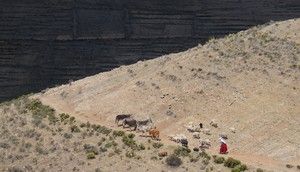 Mixed troop: A considerable mixed troop
with cows, donkeys, sheep and pigs here by an islander on the pasture
is done. We have seen merely llamas on the island none. Meanwhile
the llamas have removed because to donkeys as a Tragtiere, because
the meat of the llamas would become too tenaciously food if they before
loads had to drag. Mixed troop: A considerable mixed troop
with cows, donkeys, sheep and pigs here by an islander on the pasture
is done. We have seen merely llamas on the island none. Meanwhile
the llamas have removed because to donkeys as a Tragtiere, because
the meat of the llamas would become too tenaciously food if they before
loads had to drag. |
| |
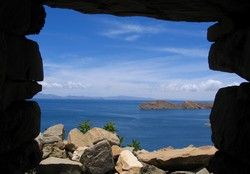 Inca's constructions: Unfortunately, from the old
Inca's constructions only a few ruins and the Terrasenfelder have
been left. One of the arrangements resembles nearly one small labyrinth,
however, from the former building only the walls stand meanwhile. Inca's constructions: Unfortunately, from the old
Inca's constructions only a few ruins and the Terrasenfelder have
been left. One of the arrangements resembles nearly one small labyrinth,
however, from the former building only the walls stand meanwhile. |
| |
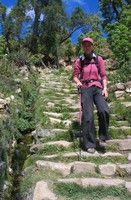 Inca's stair: In Yumani an old Inca's stair of Titikakasee
to directly on from the north after the south leads running ridge
in the island middle. Because the stair also even today the direct
way to Yumani is it has not only culturally but also infrastructurally
great importance which is why she is still very well-preserved. Inca's stair: In Yumani an old Inca's stair of Titikakasee
to directly on from the north after the south leads running ridge
in the island middle. Because the stair also even today the direct
way to Yumani is it has not only culturally but also infrastructurally
great importance which is why she is still very well-preserved. |
| |
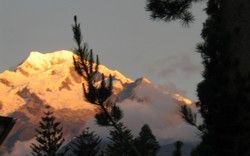 Sorata: Because our package is
not yet in La Paz, we decide to make to ourselves one more excursion
by the coach to Sorata. Actually, Sorata is there it delightfully
in the slopes of the Andes a brilliant starting point lies around
trekking tours to make, however, unfortunately, the travelling groups
will attack there and Again. We had to meet the luck in La Paz a guide
from Sorata to us has admitted honestly that even the organised tours
are attacked with guide. Nadine has said witty proofs, nevertheless,
from another travel agency the information by the flower agrees that
we would have to expect no problems if we with her company would walk
(Our guides know the boys the problems make). All that seems
to us rather half pre-arranged and thus we renounce loves on a travelling
tour, although the scenery with the Illampu is quite really breathtaking
in the background. Instead, we spend a very nice evening with a group
of Israelis in the Hostel Mirador (Hostal view). To his name all honour
makes. The photo of the Illamu is taken up from the terrace of the
Hostels. Sorata: Because our package is
not yet in La Paz, we decide to make to ourselves one more excursion
by the coach to Sorata. Actually, Sorata is there it delightfully
in the slopes of the Andes a brilliant starting point lies around
trekking tours to make, however, unfortunately, the travelling groups
will attack there and Again. We had to meet the luck in La Paz a guide
from Sorata to us has admitted honestly that even the organised tours
are attacked with guide. Nadine has said witty proofs, nevertheless,
from another travel agency the information by the flower agrees that
we would have to expect no problems if we with her company would walk
(Our guides know the boys the problems make). All that seems
to us rather half pre-arranged and thus we renounce loves on a travelling
tour, although the scenery with the Illampu is quite really breathtaking
in the background. Instead, we spend a very nice evening with a group
of Israelis in the Hostel Mirador (Hostal view). To his name all honour
makes. The photo of the Illamu is taken up from the terrace of the
Hostels. |
| |
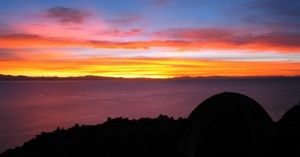 The package of VAUDE is there! From Sorata
we call over again at the German message in La Paz and are completely
surprised when we hear that our package has come. Because the package
should have been there according to German post within 4-6 days and
now meanwhile 4 weeks have passed we have counted not really more
on it it depends. After to us the watertight bicycle pockets of Vaude
will accompany Space II for 2 years we this time from VAUDE generous-wise
with rain clothing and long bicycle trousers equipped already for
4.5 years and the dome tent which we may "test"! Quite a hearty thank-you
over again to the company VAUDE and in particular in Tobi and Janet! The package of VAUDE is there! From Sorata
we call over again at the German message in La Paz and are completely
surprised when we hear that our package has come. Because the package
should have been there according to German post within 4-6 days and
now meanwhile 4 weeks have passed we have counted not really more
on it it depends. After to us the watertight bicycle pockets of Vaude
will accompany Space II for 2 years we this time from VAUDE generous-wise
with rain clothing and long bicycle trousers equipped already for
4.5 years and the dome tent which we may "test"! Quite a hearty thank-you
over again to the company VAUDE and in particular in Tobi and Janet! |
| |
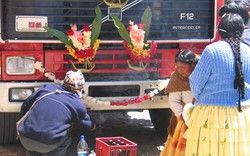 Carblessing: Every day cars are blest before the basilica
in Cpacabana by a priest or by a bolivianische amateur priest (presumably
shaman, nevertheless, with rosary). While the blessing Catholic ecclesiastical
is rather traditional and scarce a little bit more expenditure pursues
of the Schamane. Only he gives to the car as well as the driver and
all members of the family a blessing. Afterwards he goes with incense
around the car decorated with flowers and rings with a small bell
in particular with the engine and with all tyres. Now the car owners
get an other blessing before the car with beer (sometimes also champagne)
vollgespritzt becomes, Again the tyres get the special attention of
the shaman, nevertheless, also the interior becomes nicely wet. Then,
besides, still wrecks are often lighted by the owners. The whole ceremony
maybe lasts 5 minutes and with the big Lkws also sometimes a little
longer (bigger engine, more tyre). For the end everybody is embraced
over again by the shaman, before he devotes himself to the next car.
Now often walk over again all member of the family successively around
her car and splash it over again with beer and also this time the
tyre special attention is dedicated. Carblessing: Every day cars are blest before the basilica
in Cpacabana by a priest or by a bolivianische amateur priest (presumably
shaman, nevertheless, with rosary). While the blessing Catholic ecclesiastical
is rather traditional and scarce a little bit more expenditure pursues
of the Schamane. Only he gives to the car as well as the driver and
all members of the family a blessing. Afterwards he goes with incense
around the car decorated with flowers and rings with a small bell
in particular with the engine and with all tyres. Now the car owners
get an other blessing before the car with beer (sometimes also champagne)
vollgespritzt becomes, Again the tyres get the special attention of
the shaman, nevertheless, also the interior becomes nicely wet. Then,
besides, still wrecks are often lighted by the owners. The whole ceremony
maybe lasts 5 minutes and with the big Lkws also sometimes a little
longer (bigger engine, more tyre). For the end everybody is embraced
over again by the shaman, before he devotes himself to the next car.
Now often walk over again all member of the family successively around
her car and splash it over again with beer and also this time the
tyre special attention is dedicated. |
| |
|
|
I
BOOKLET
available
for
DONATION!

50pages, 80 b/w photos, background
infos, stories, ...
Just send your donation
to our
Pay
Pal account: nadinepuschkasch@yahoo.de
and email us your post
address and we´ll send it to you.
|
| |
| |
|
Like to place your Ad here?
Just e-mail to:
martinlunz@yahoo.de
|
| |
| |
|
You
liked our website and like to contribute?
Our Pay
Pal account is: nadinepuschkasch@yahoo.de
|
|
| |
|
